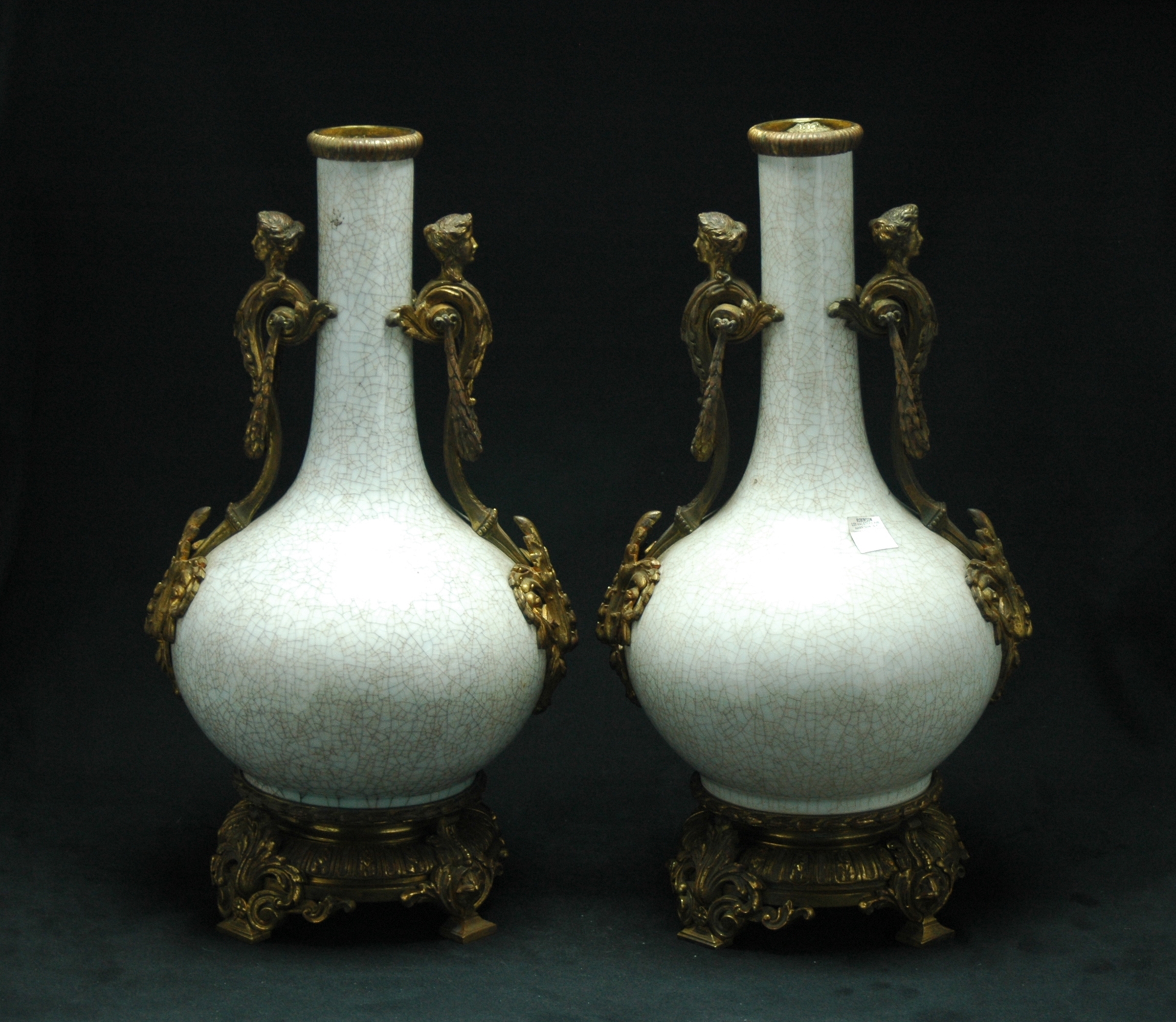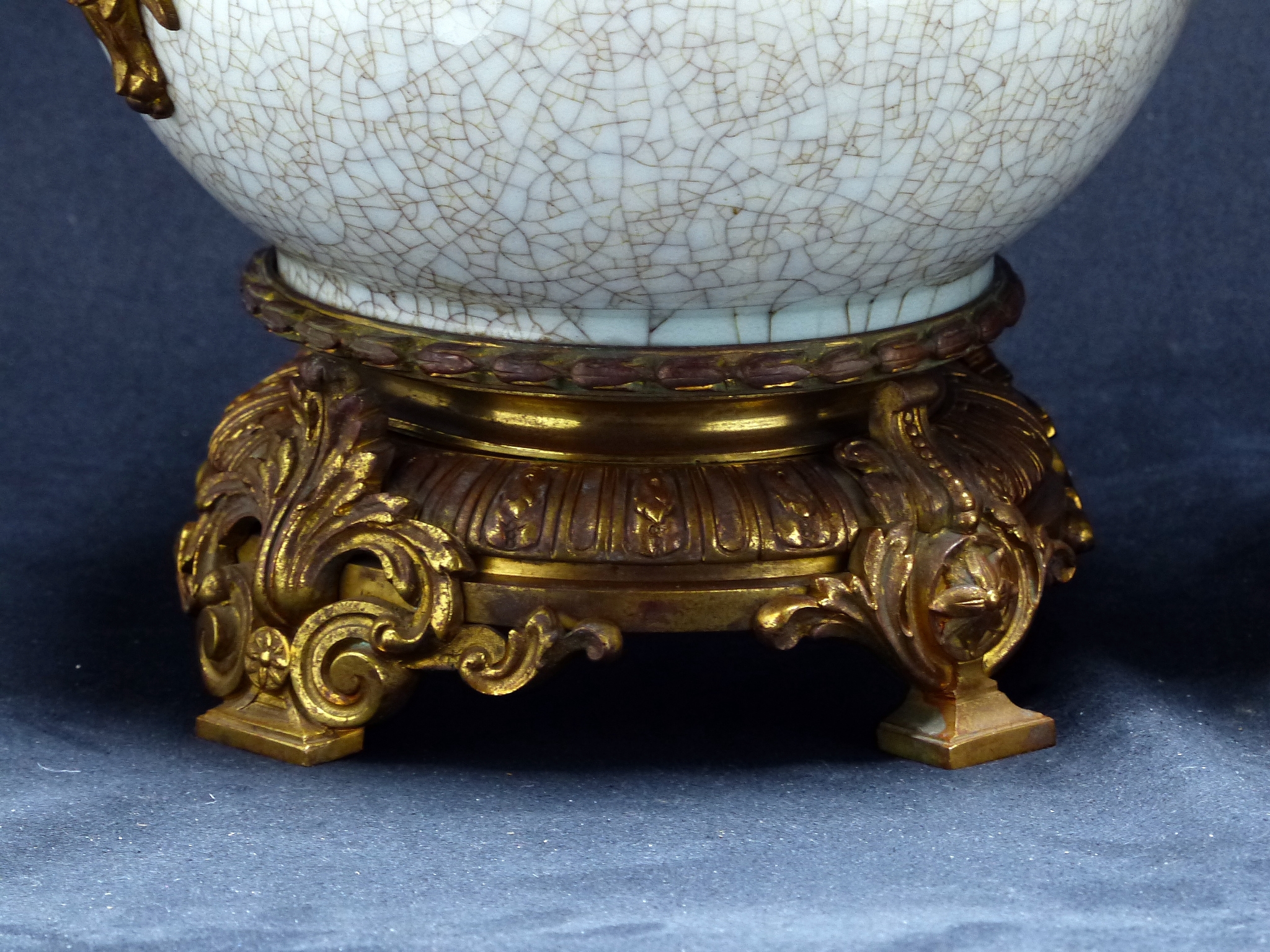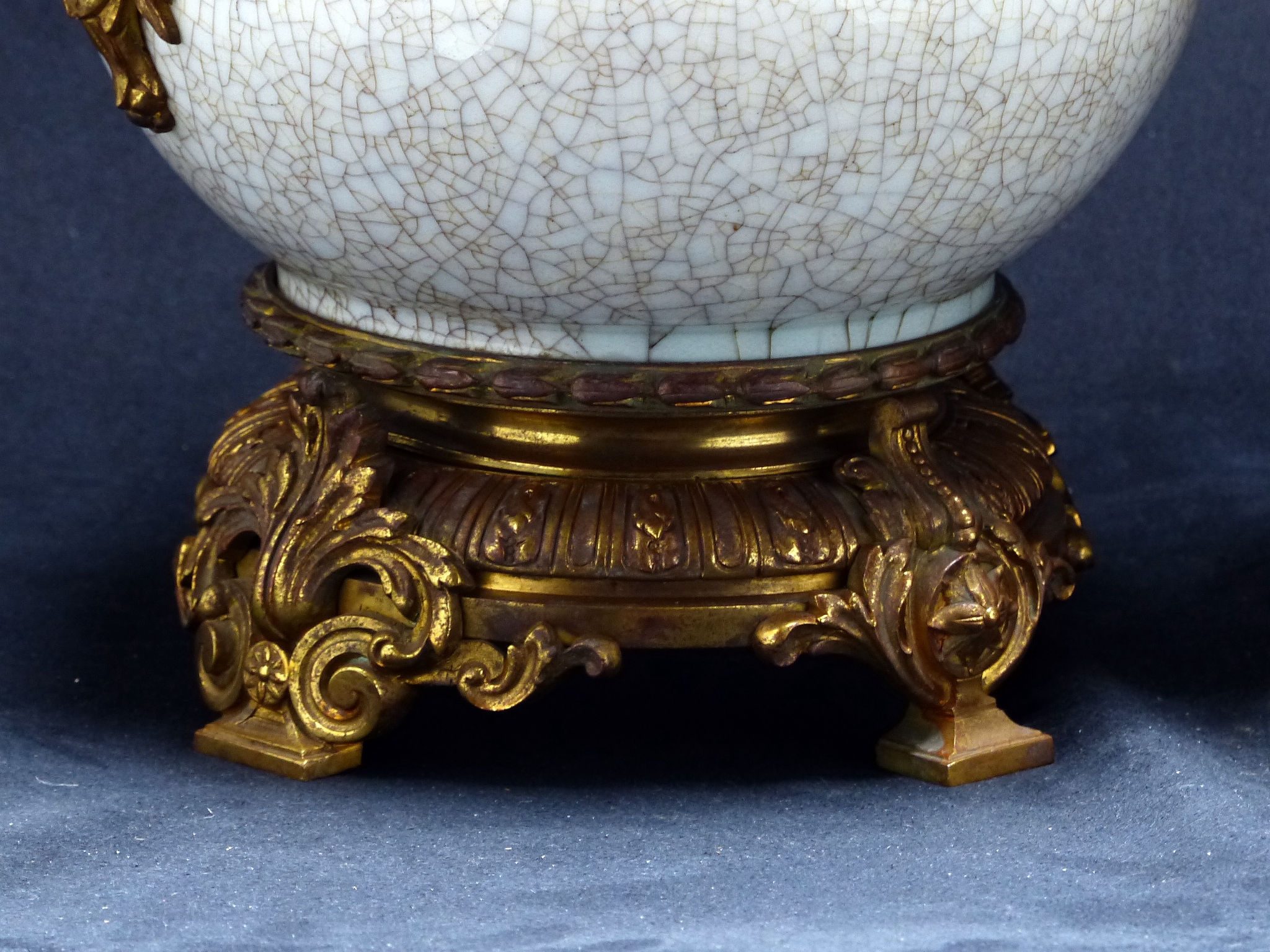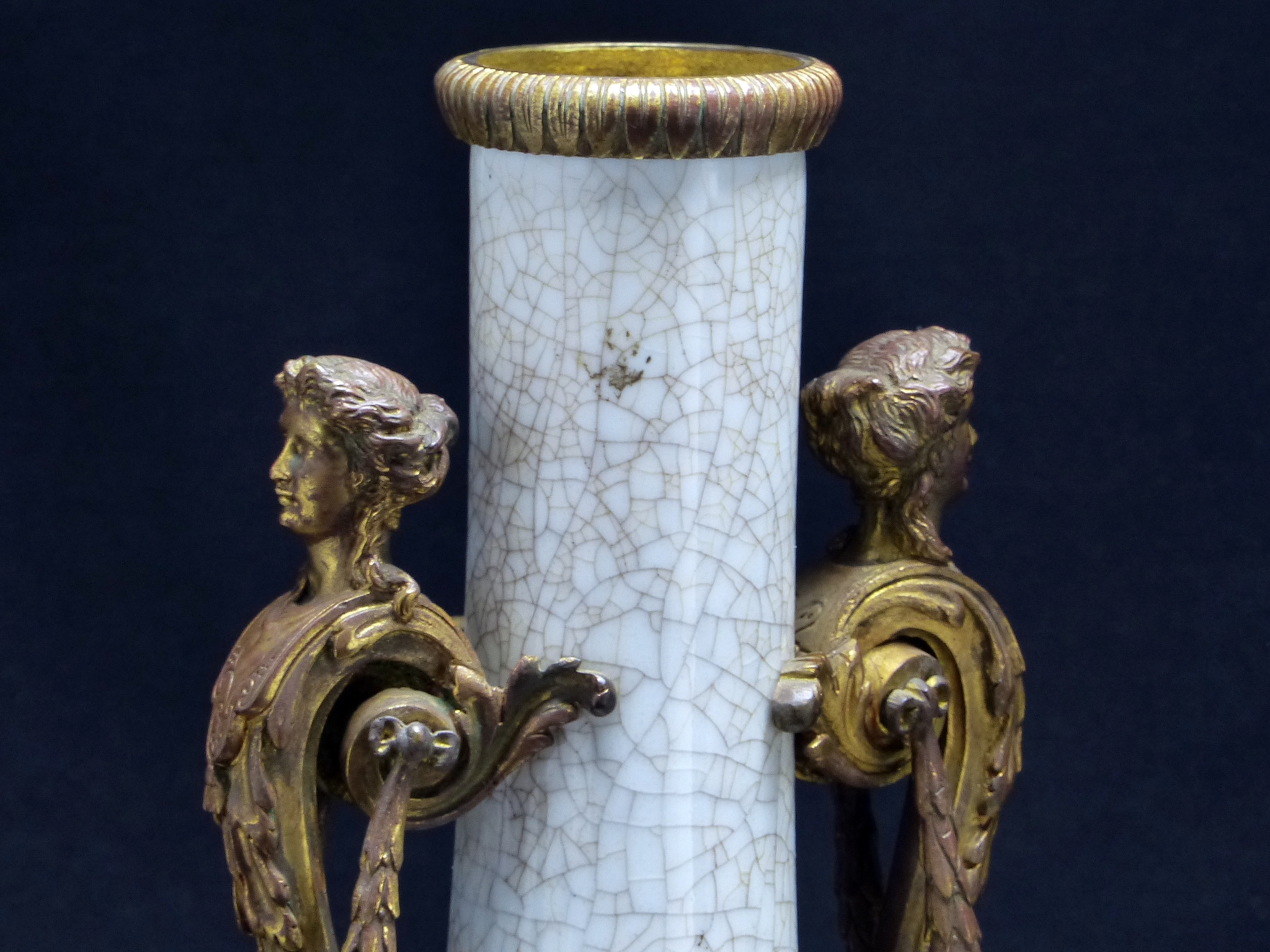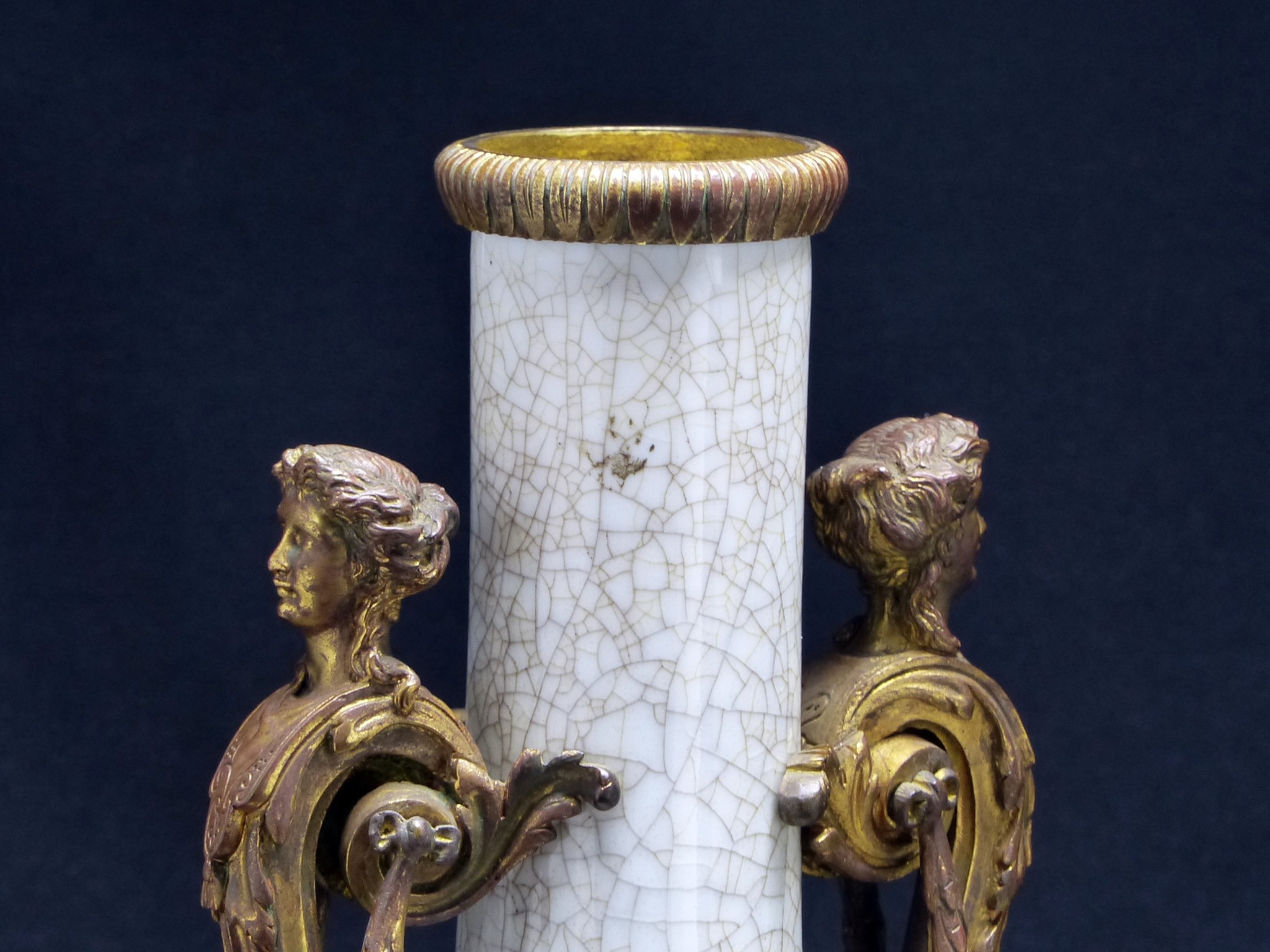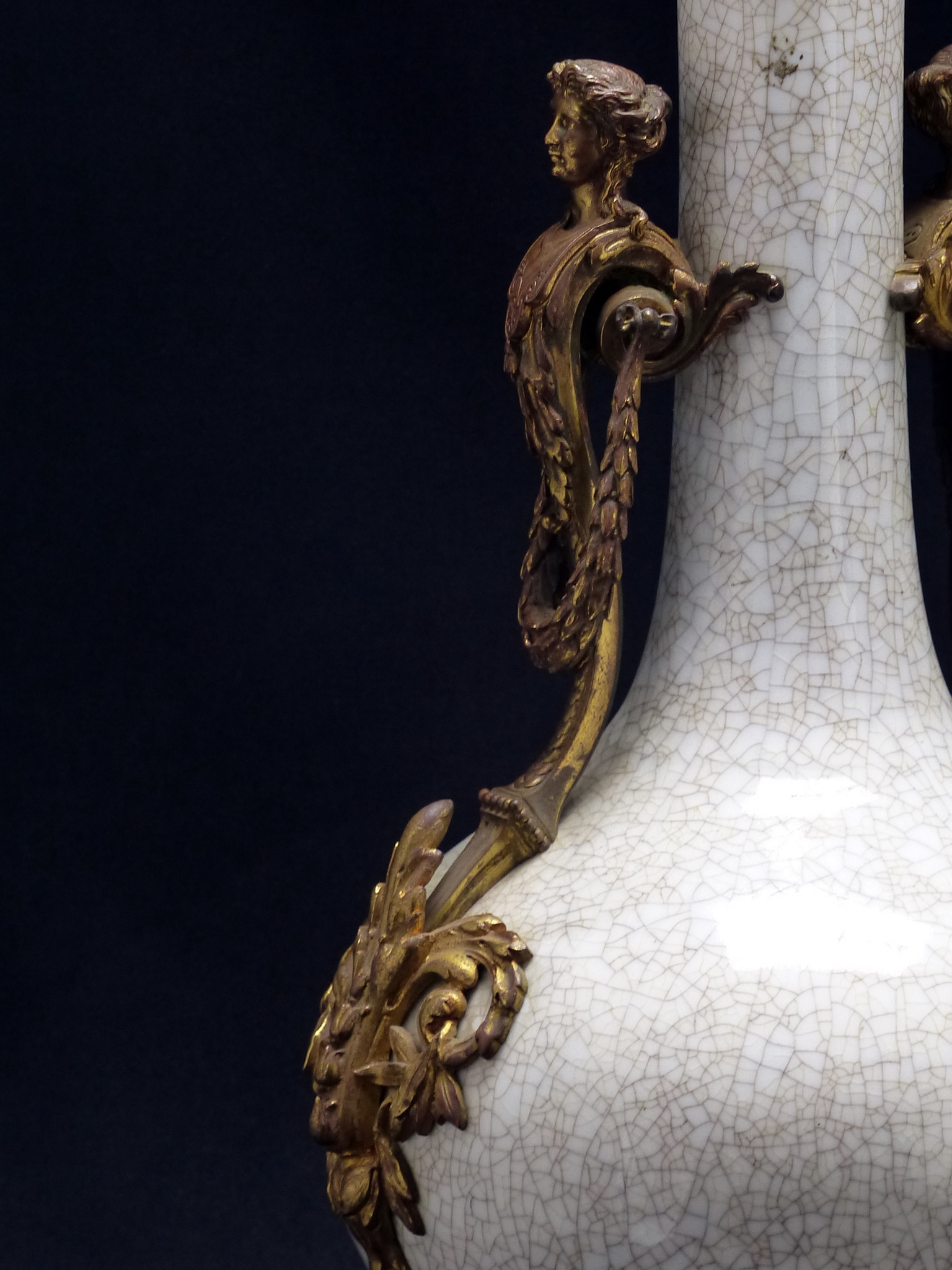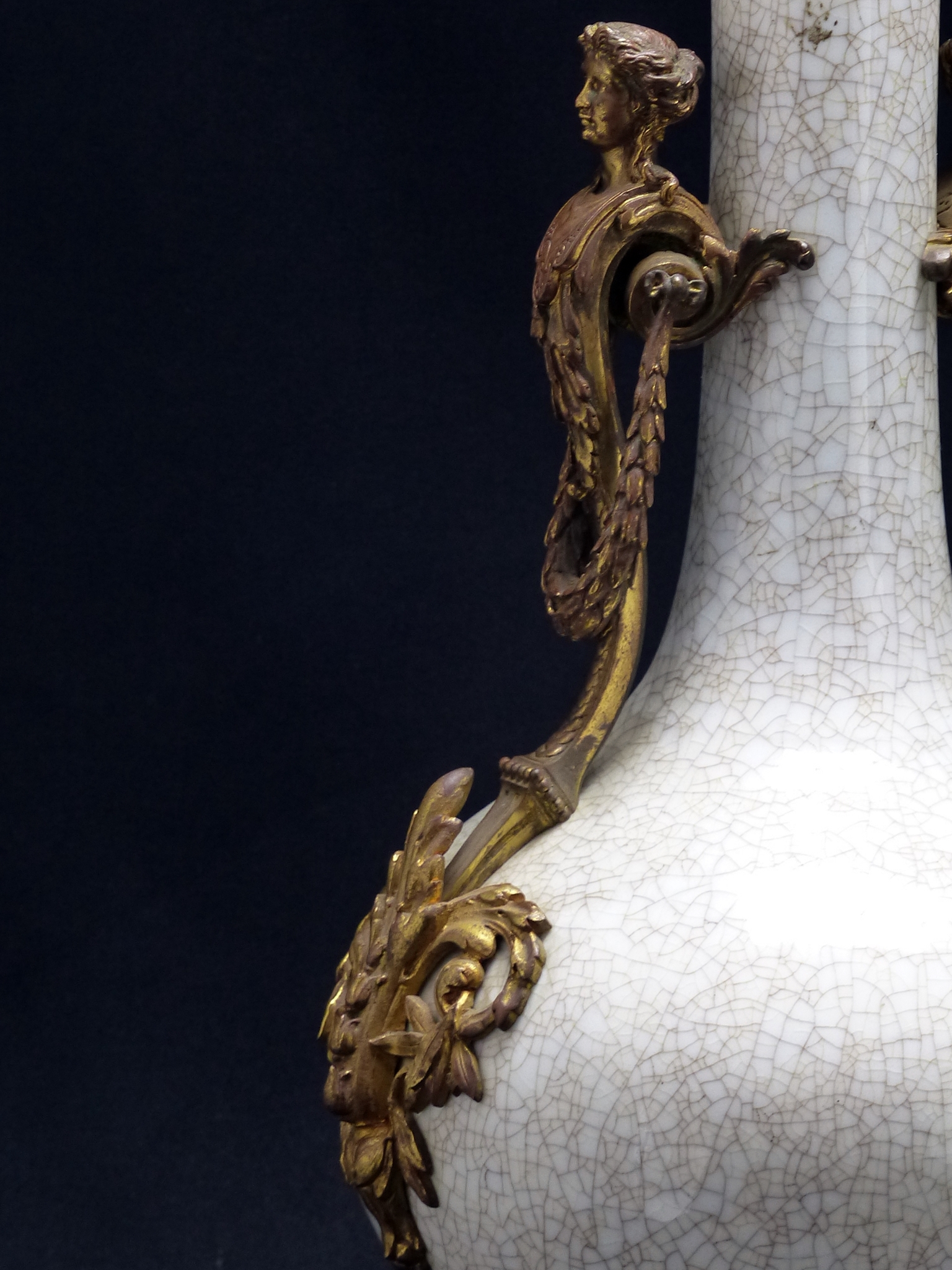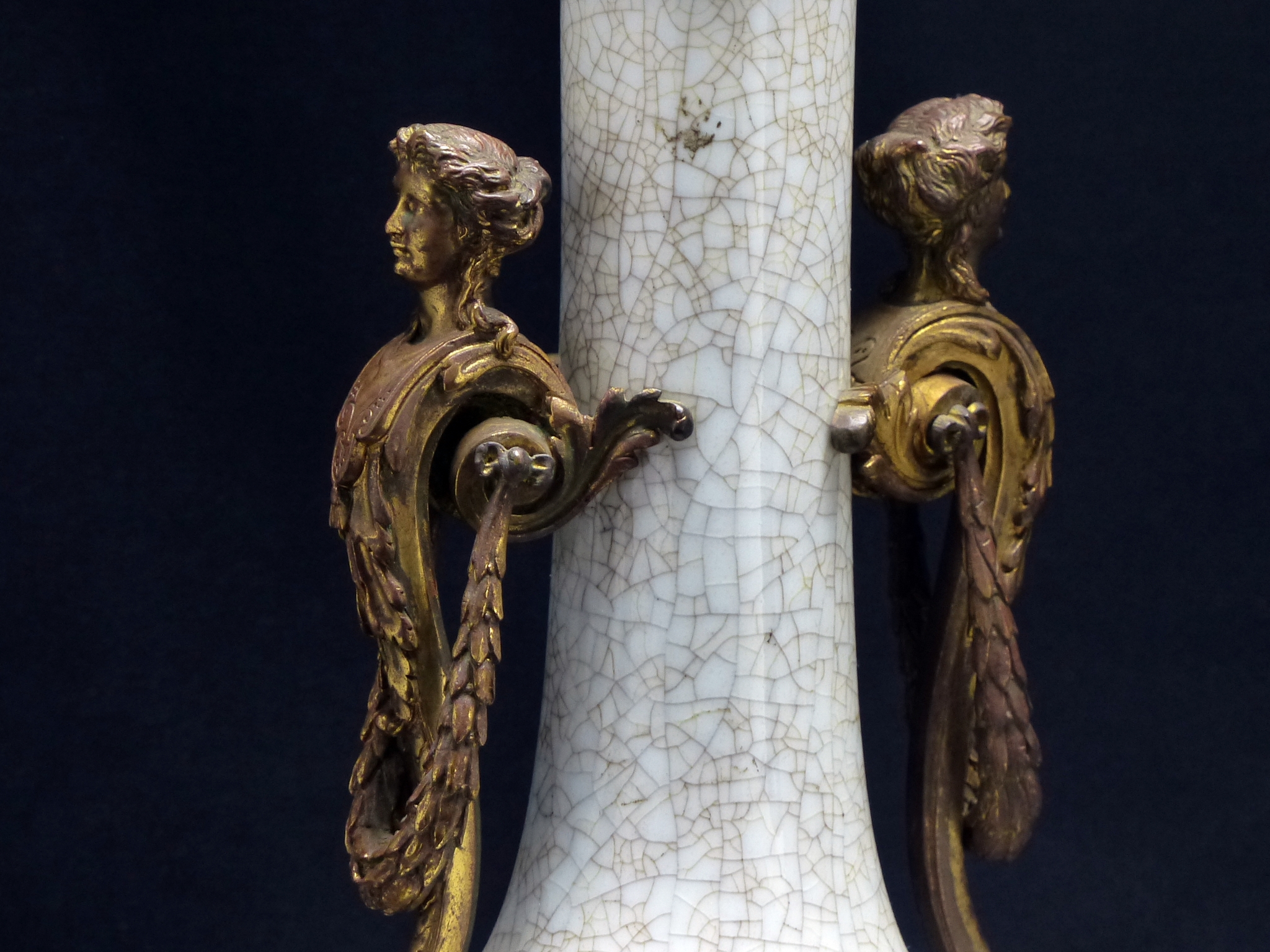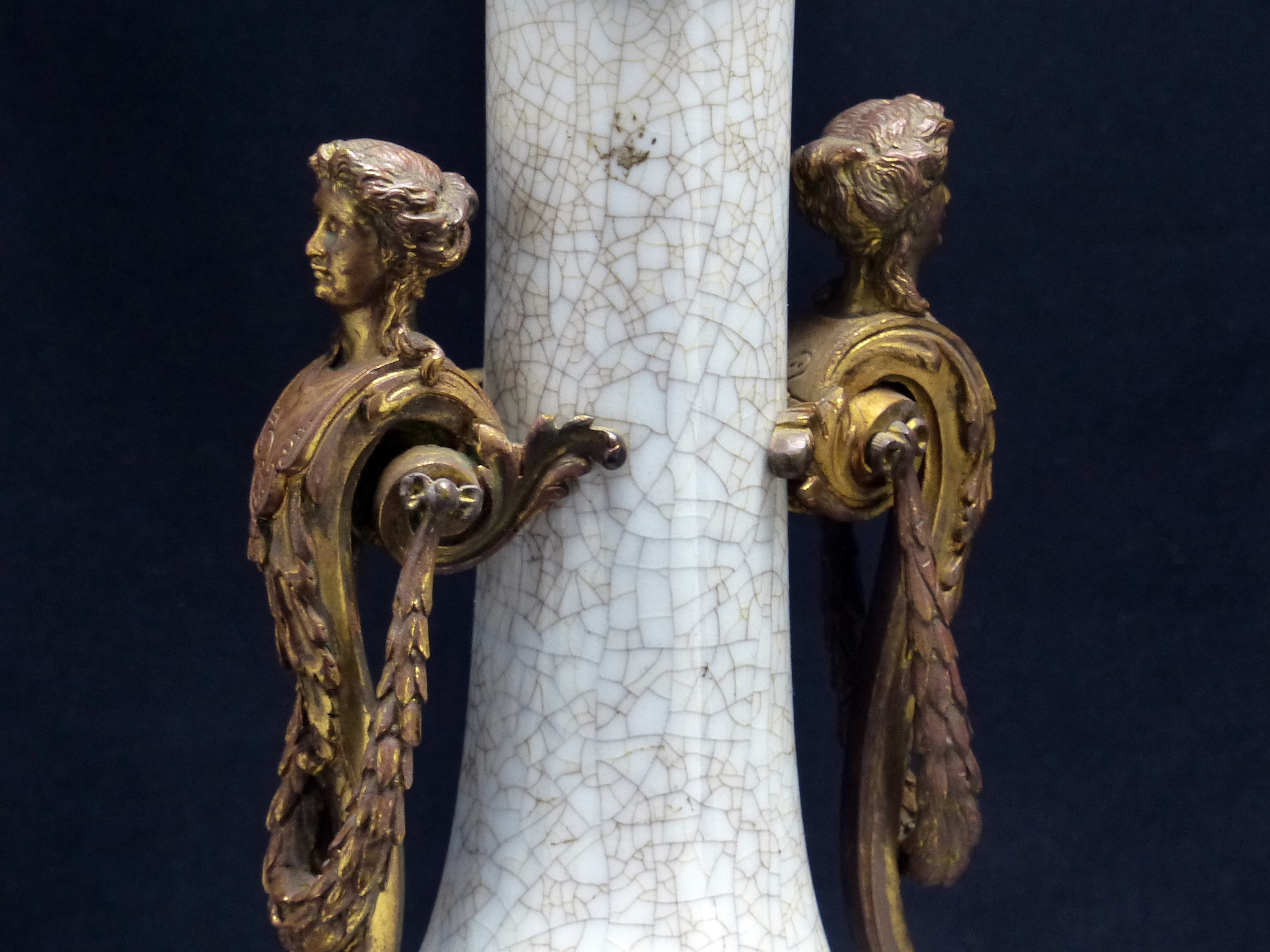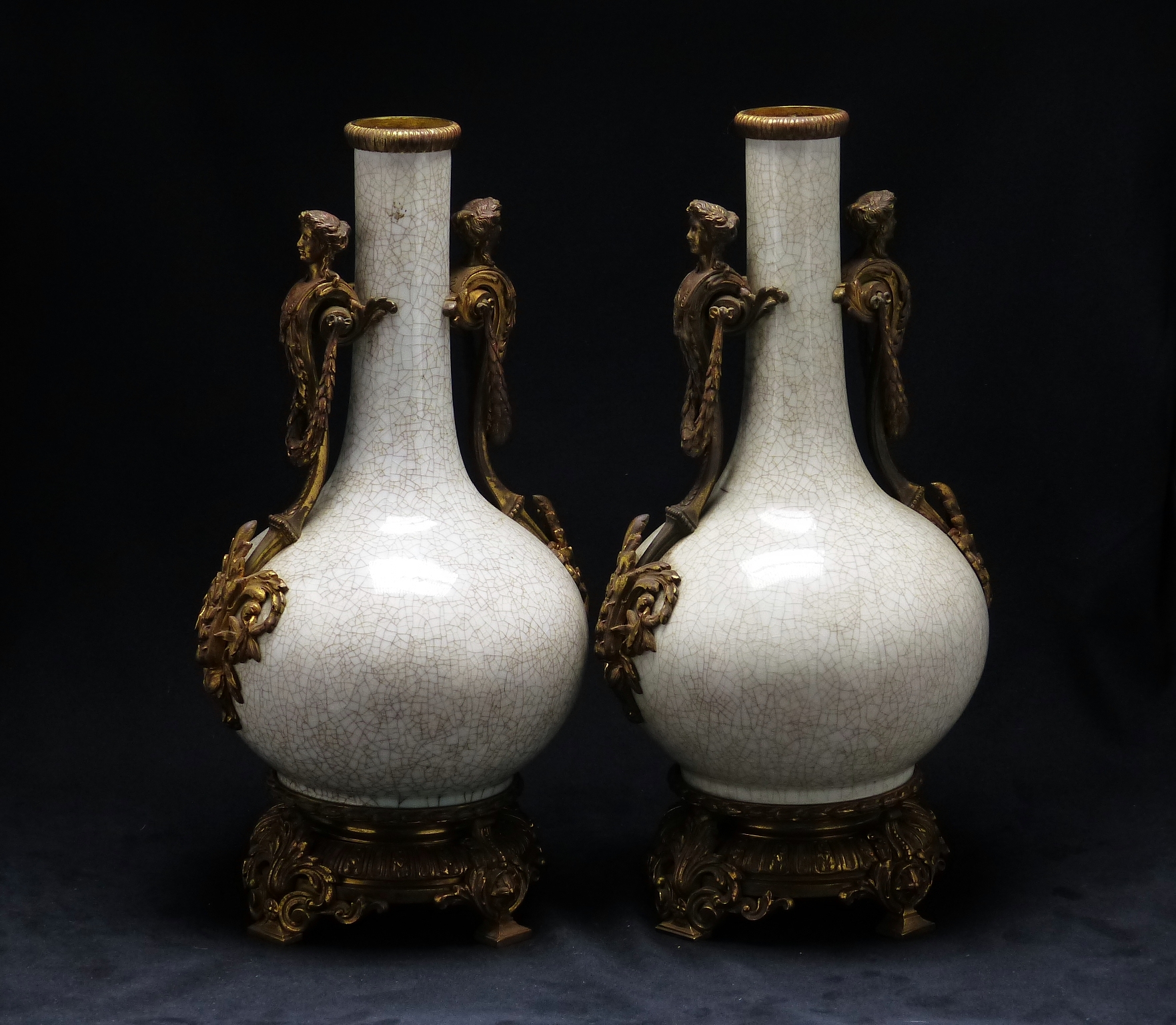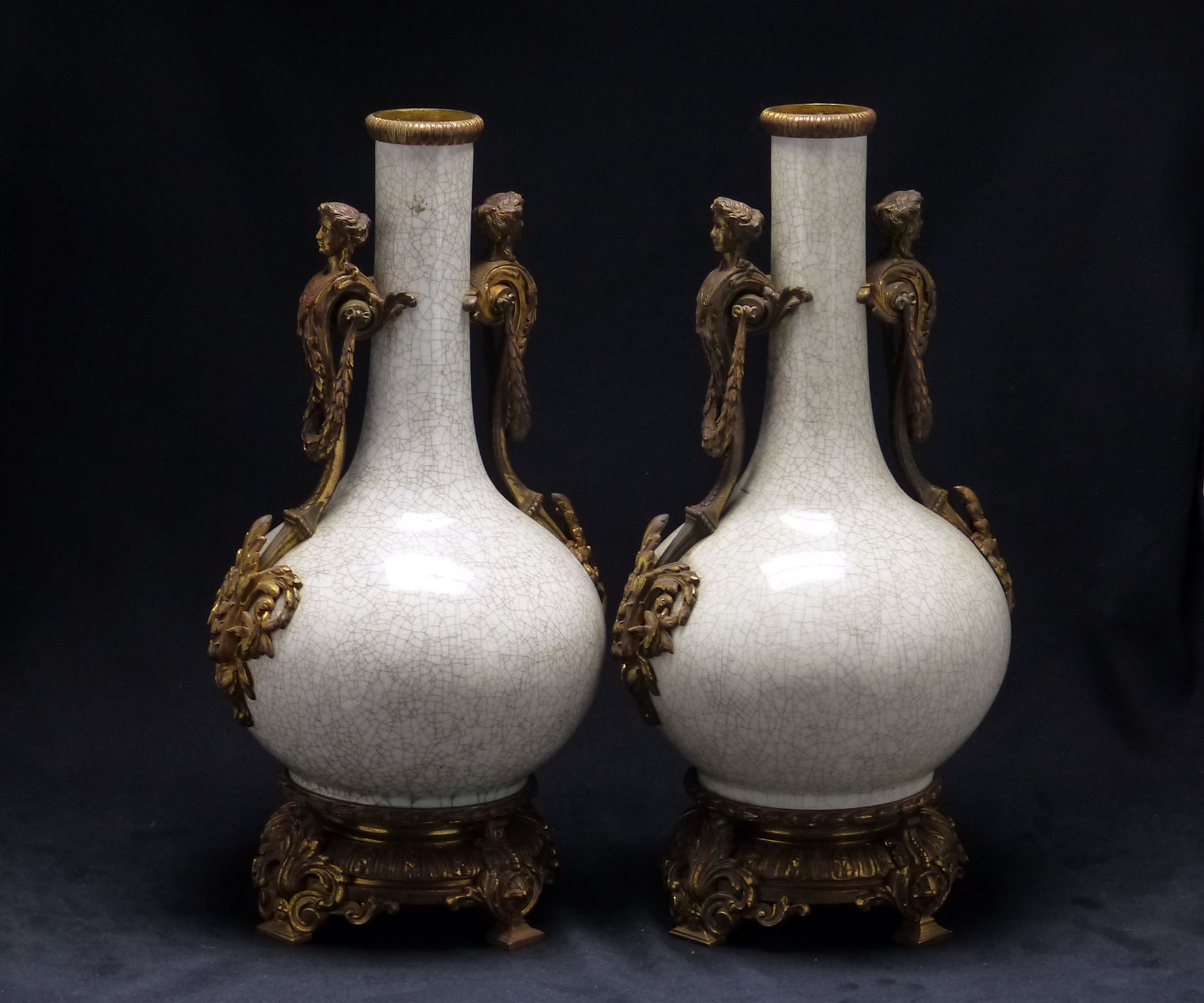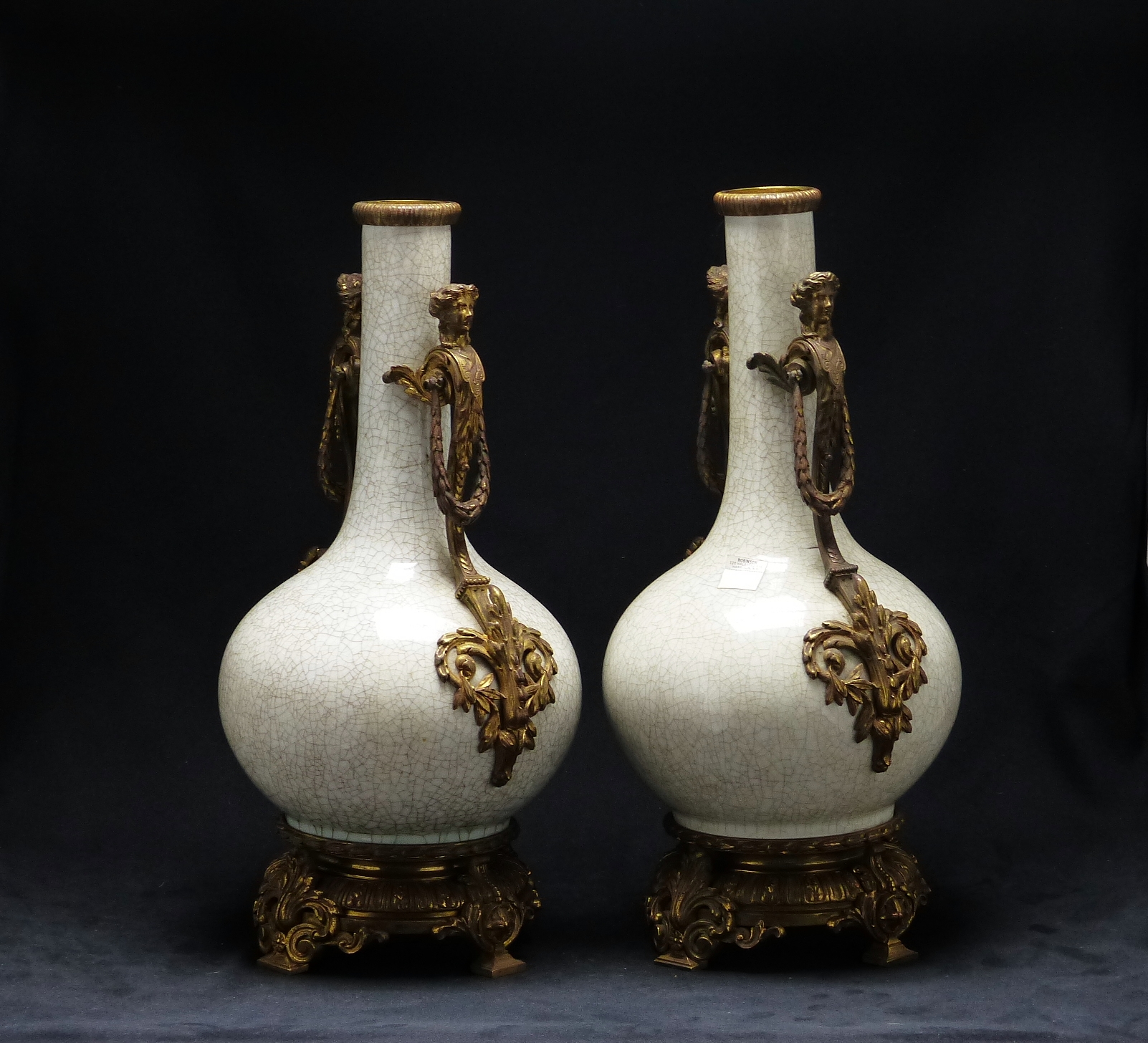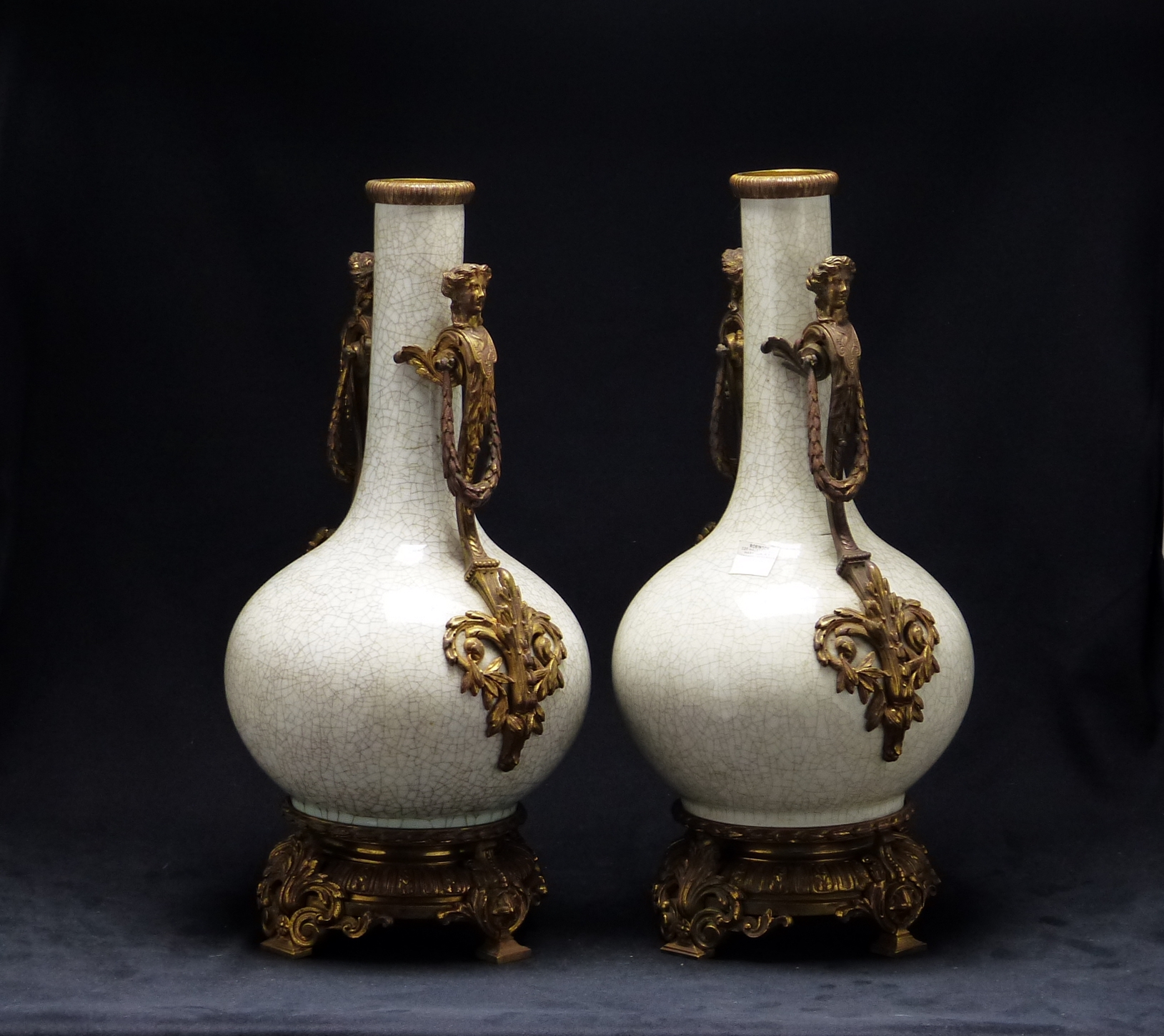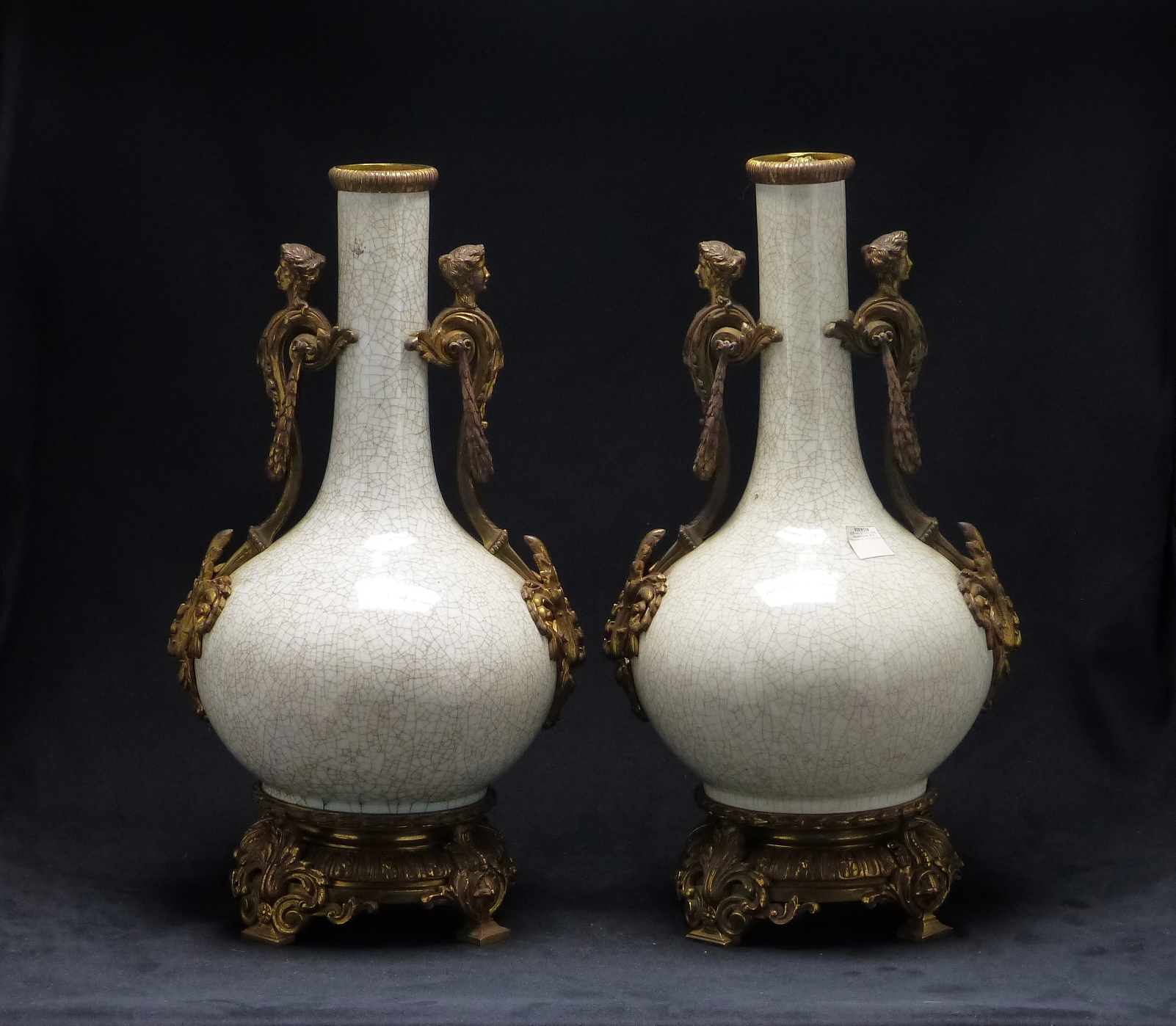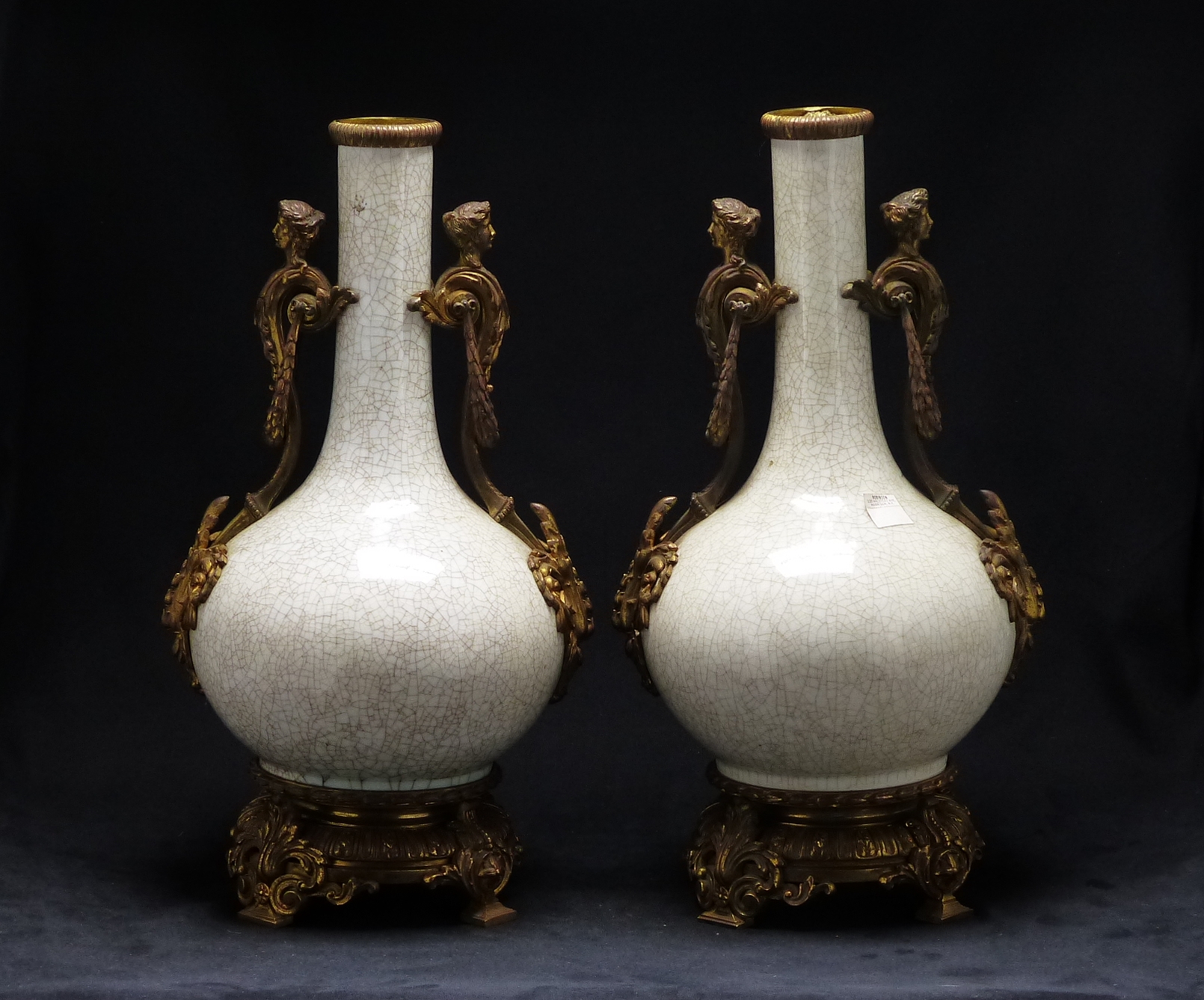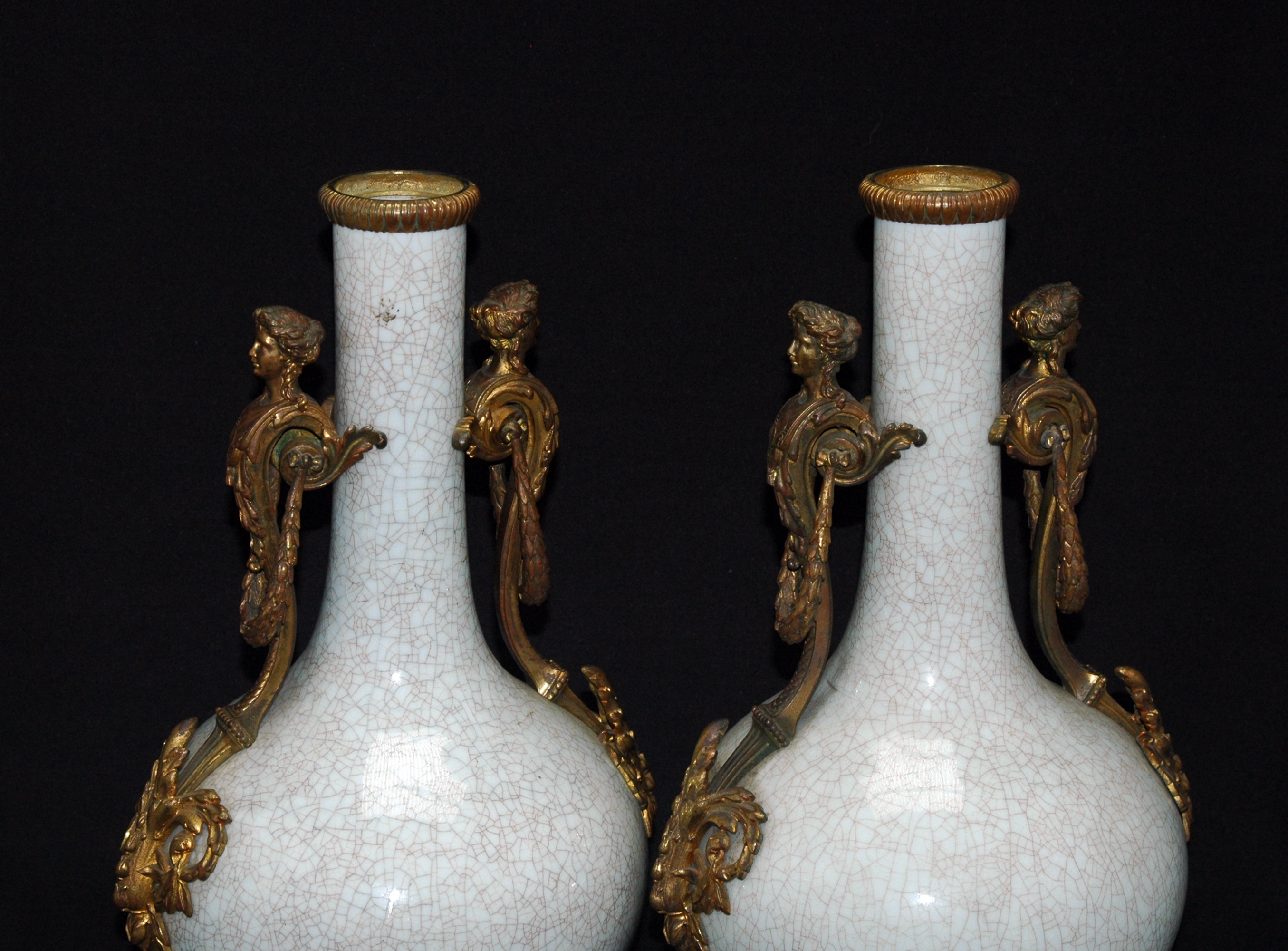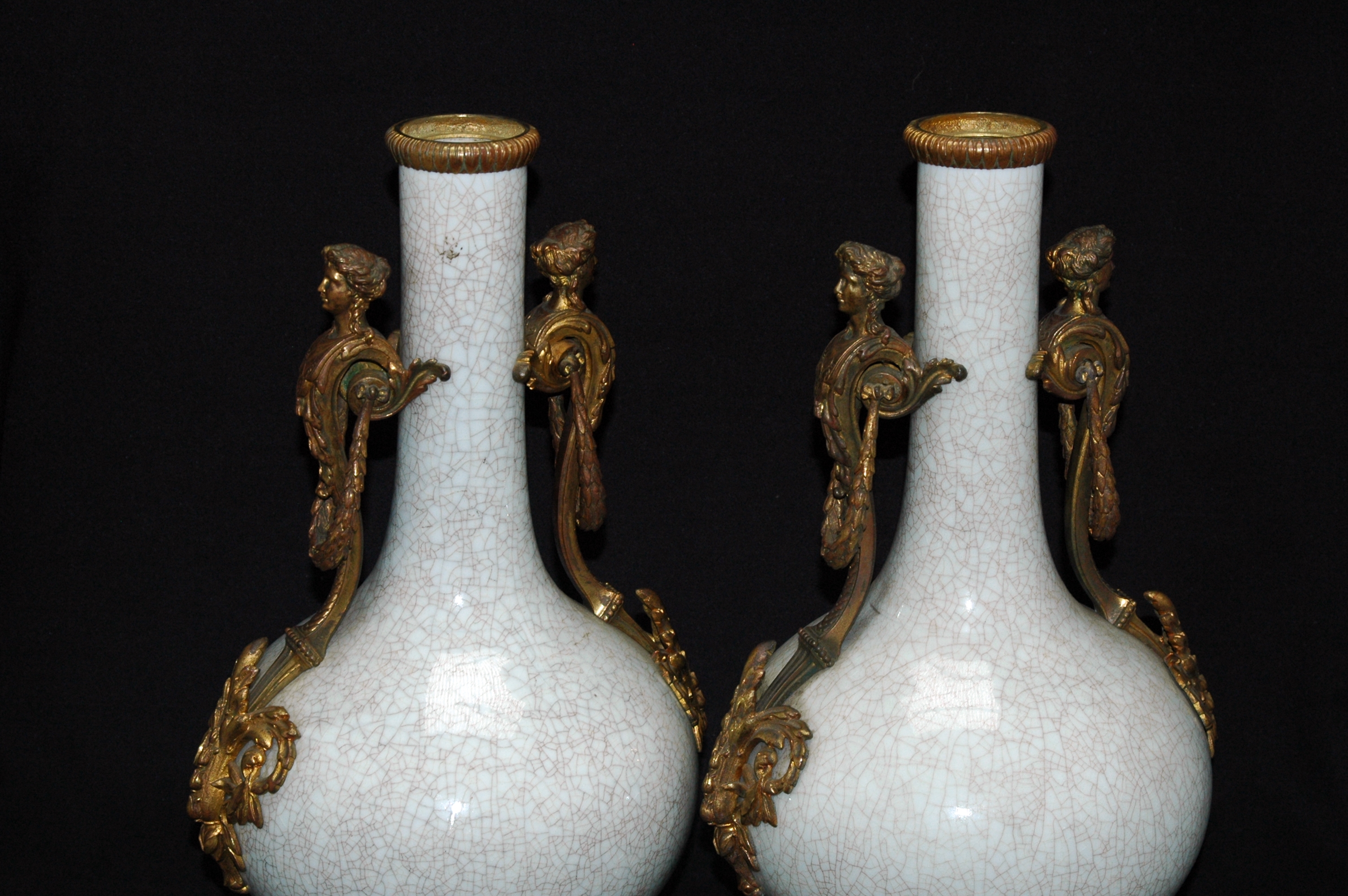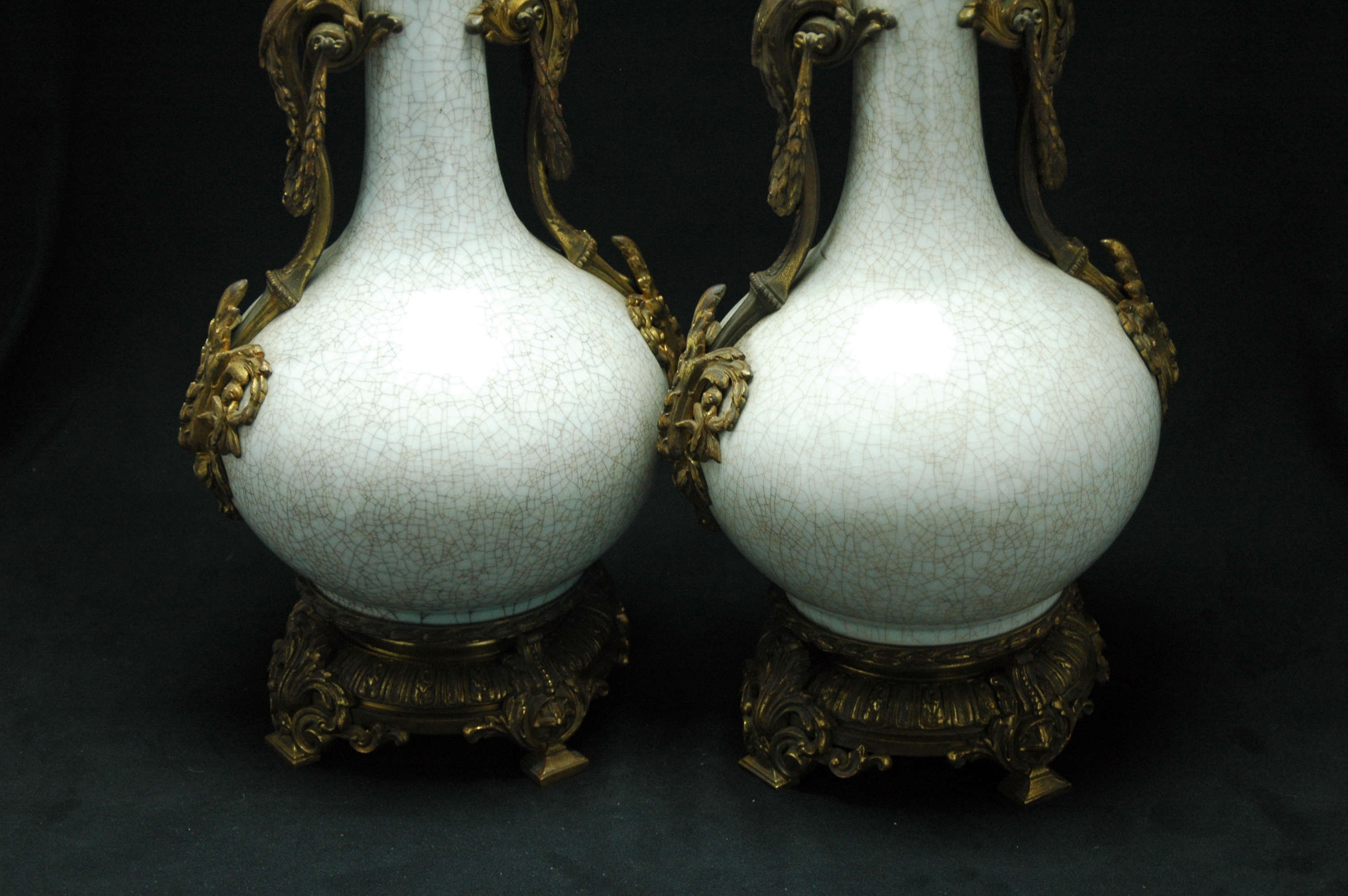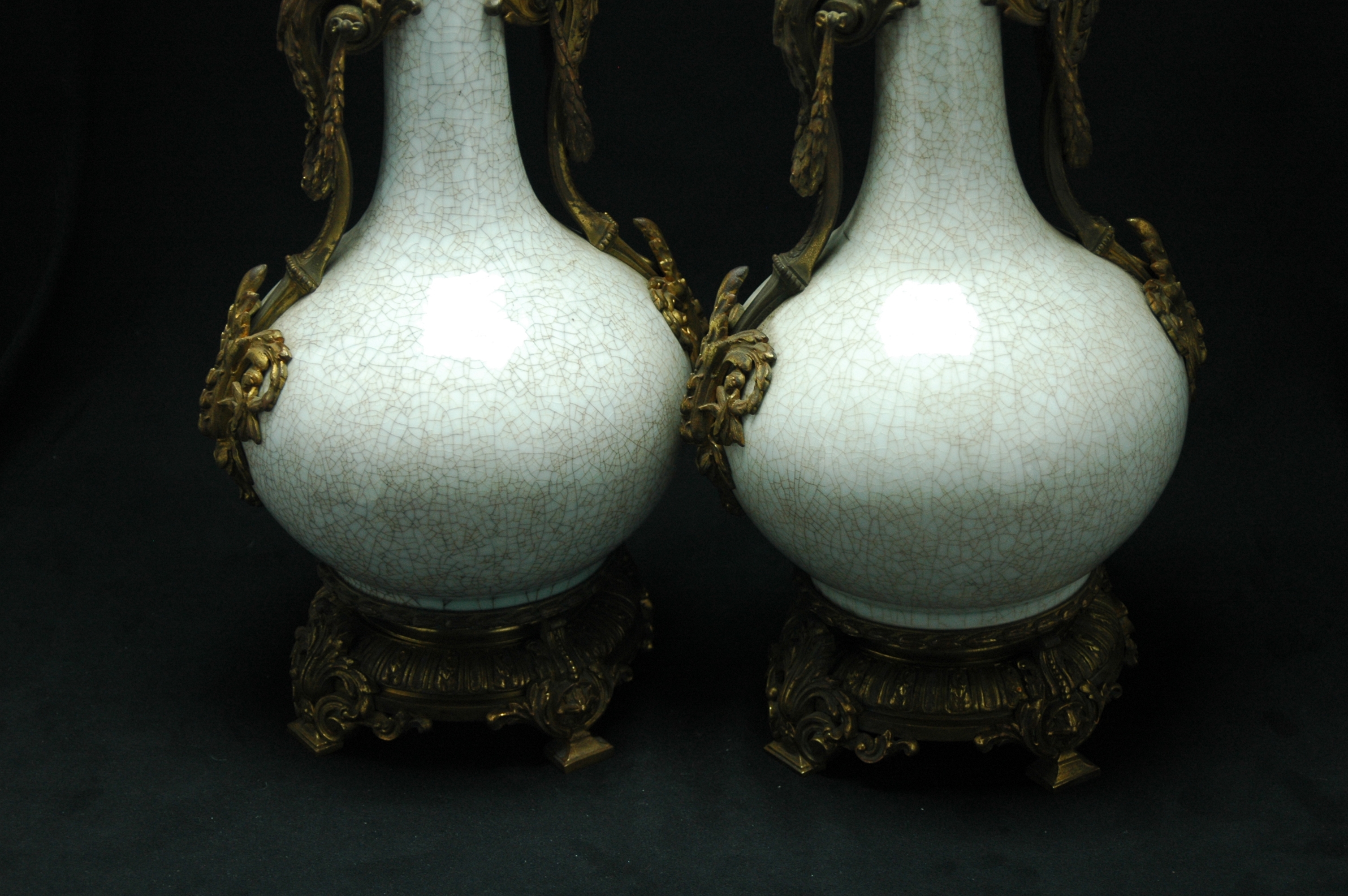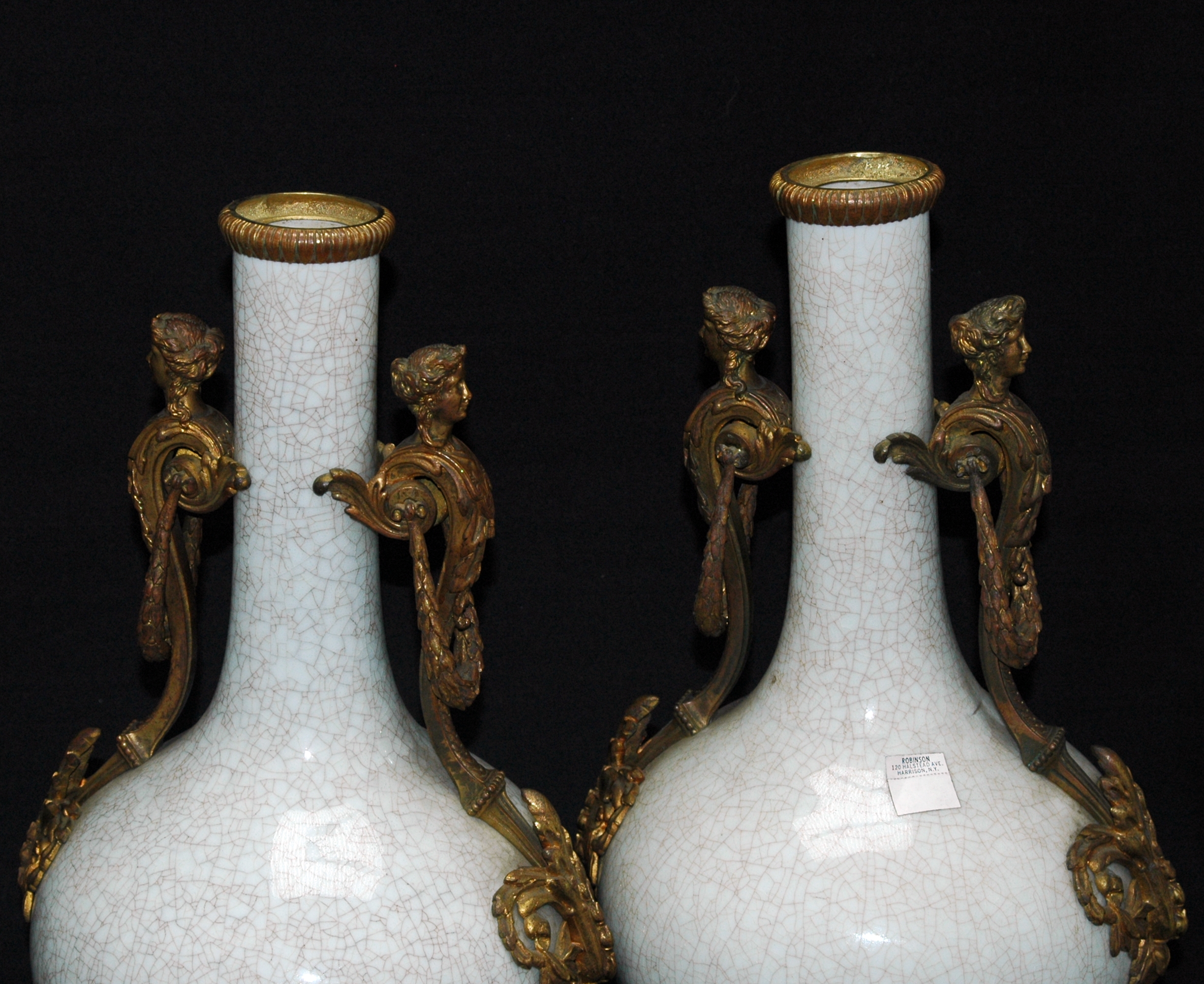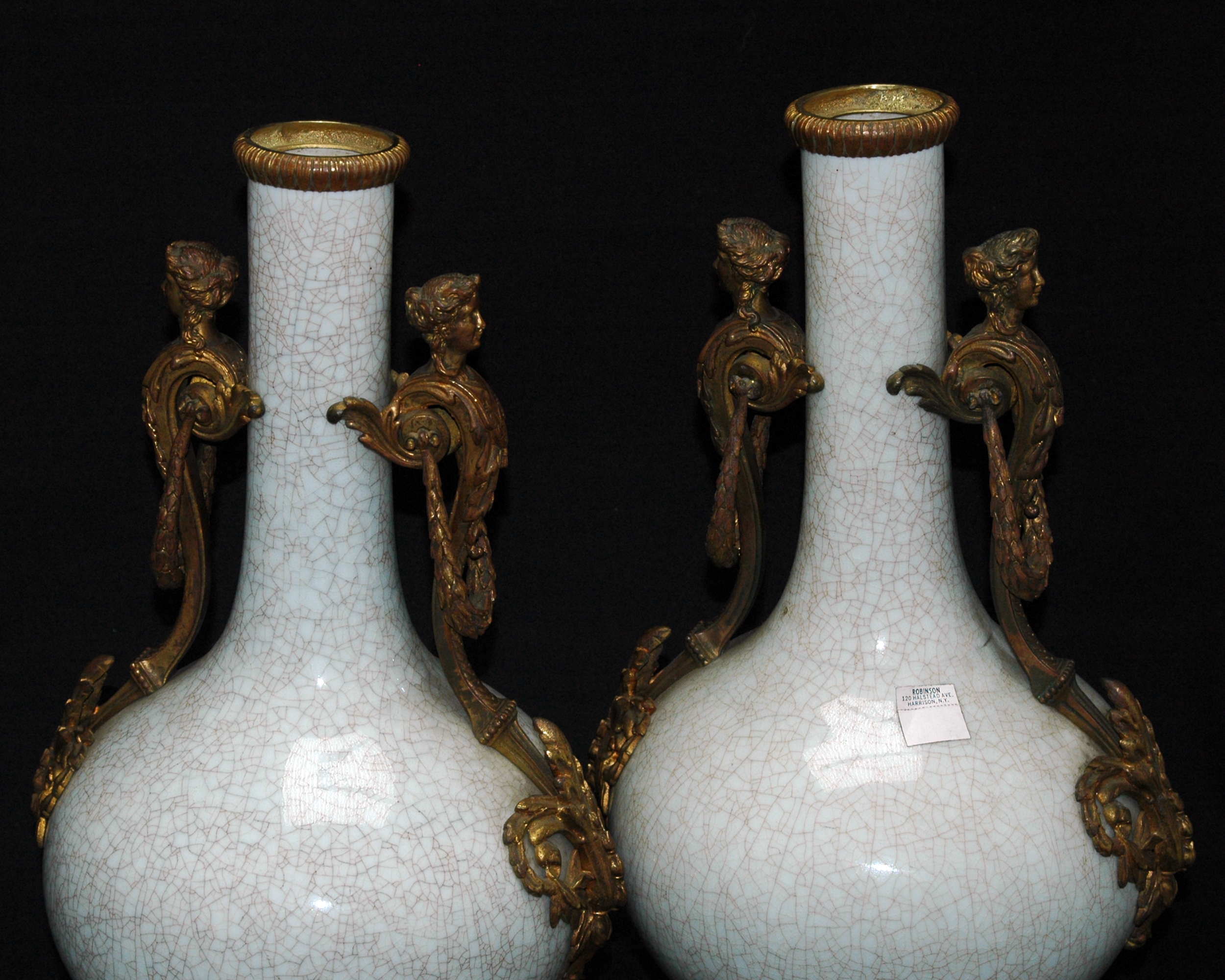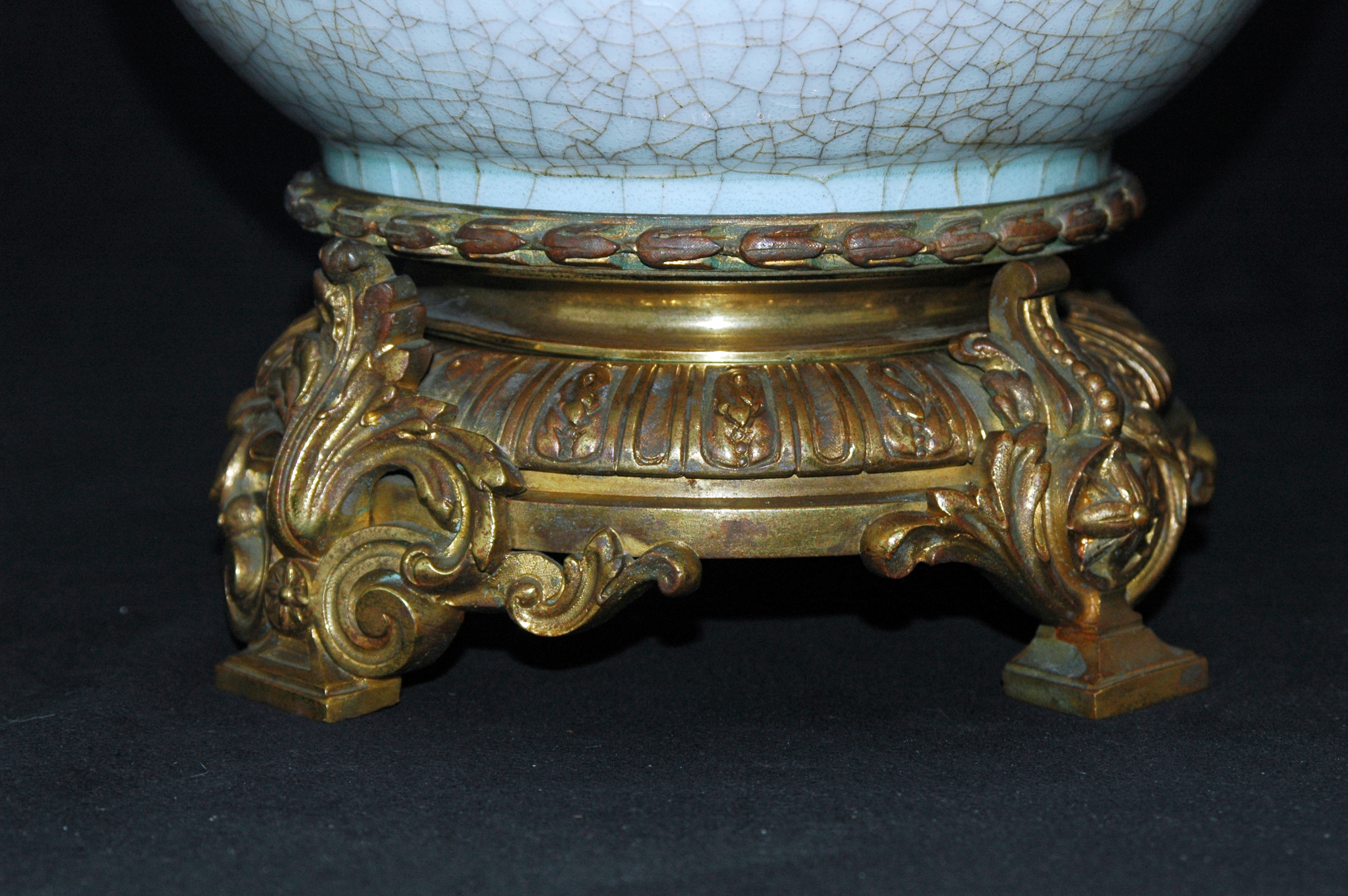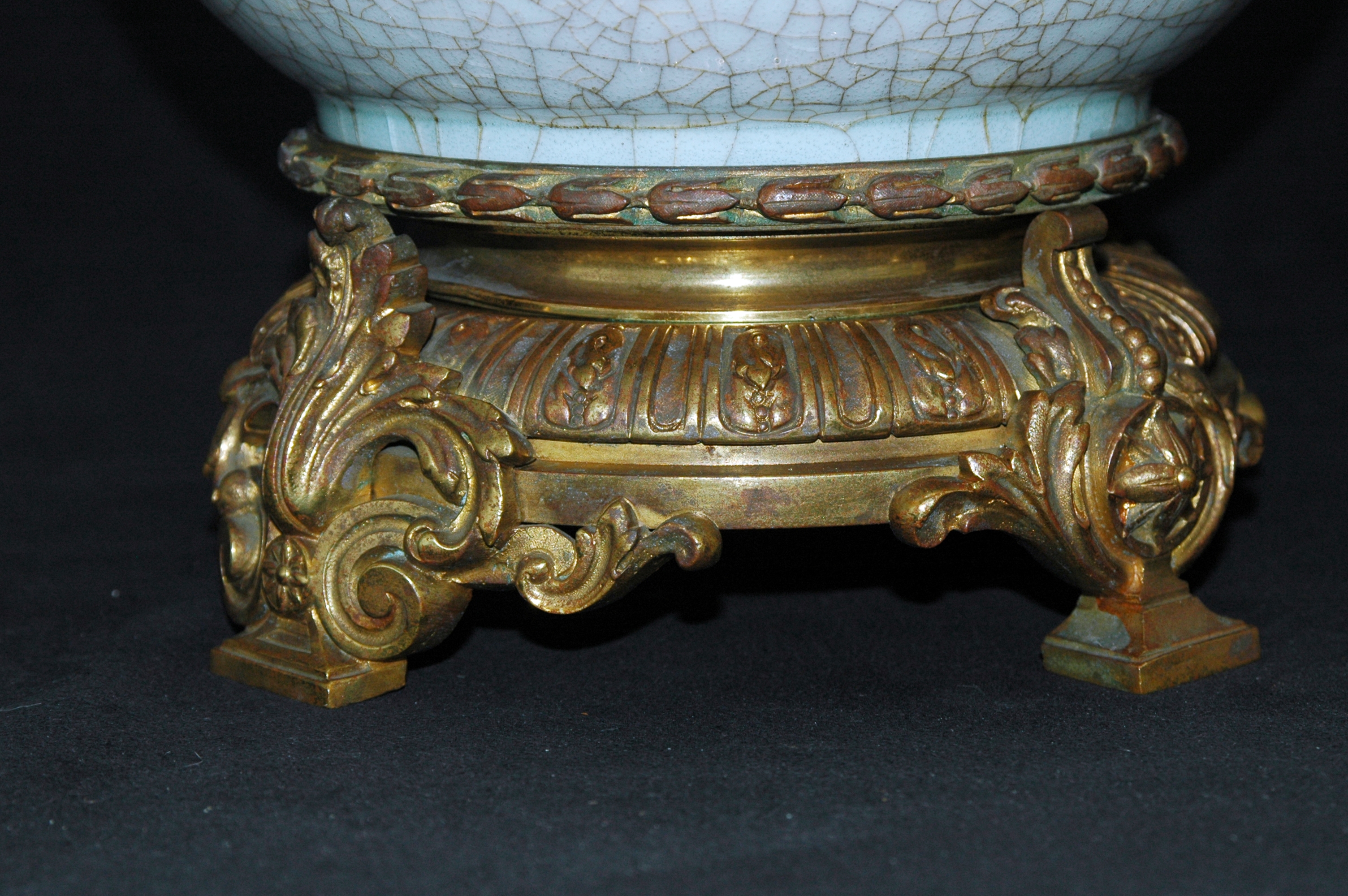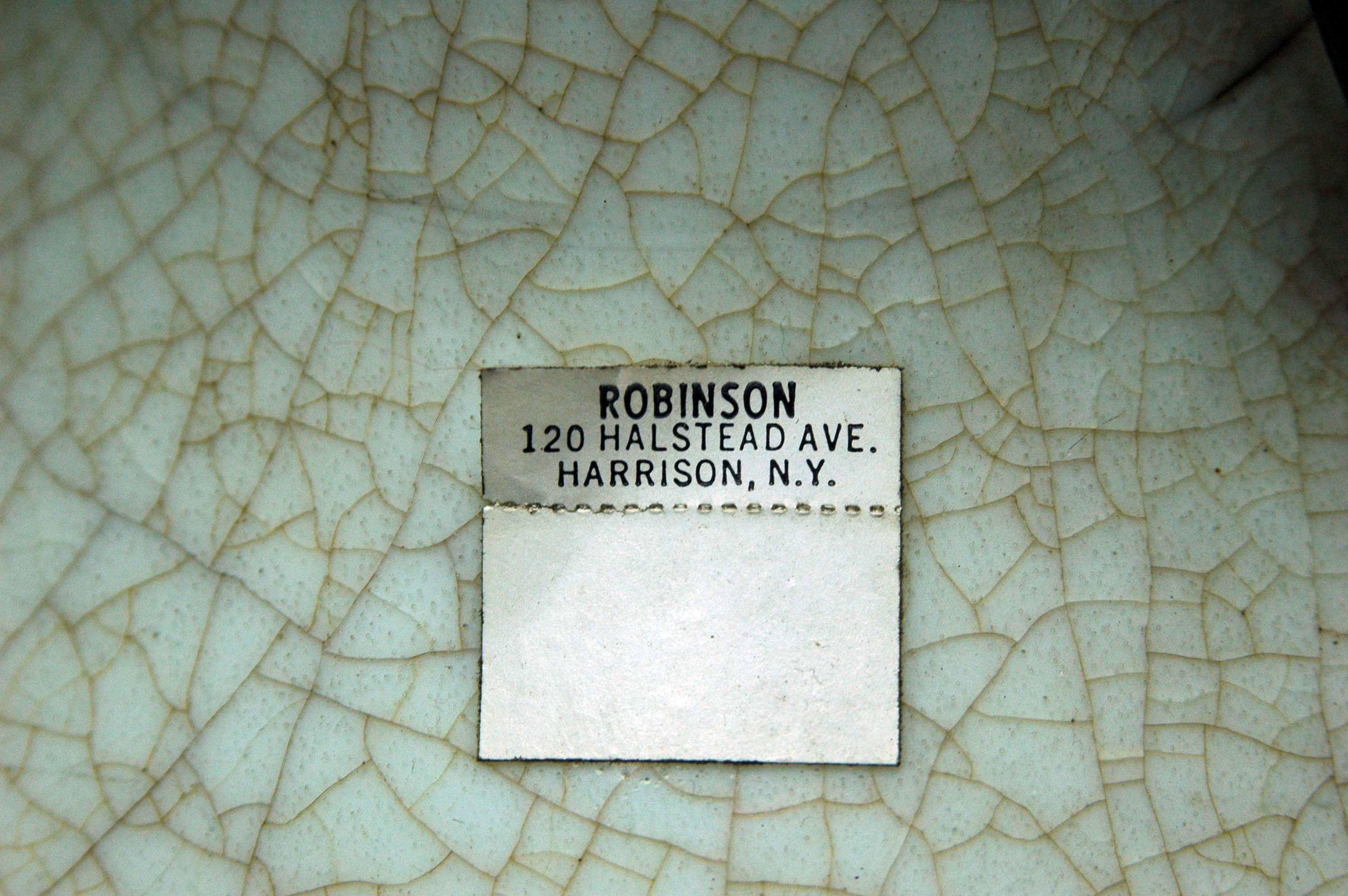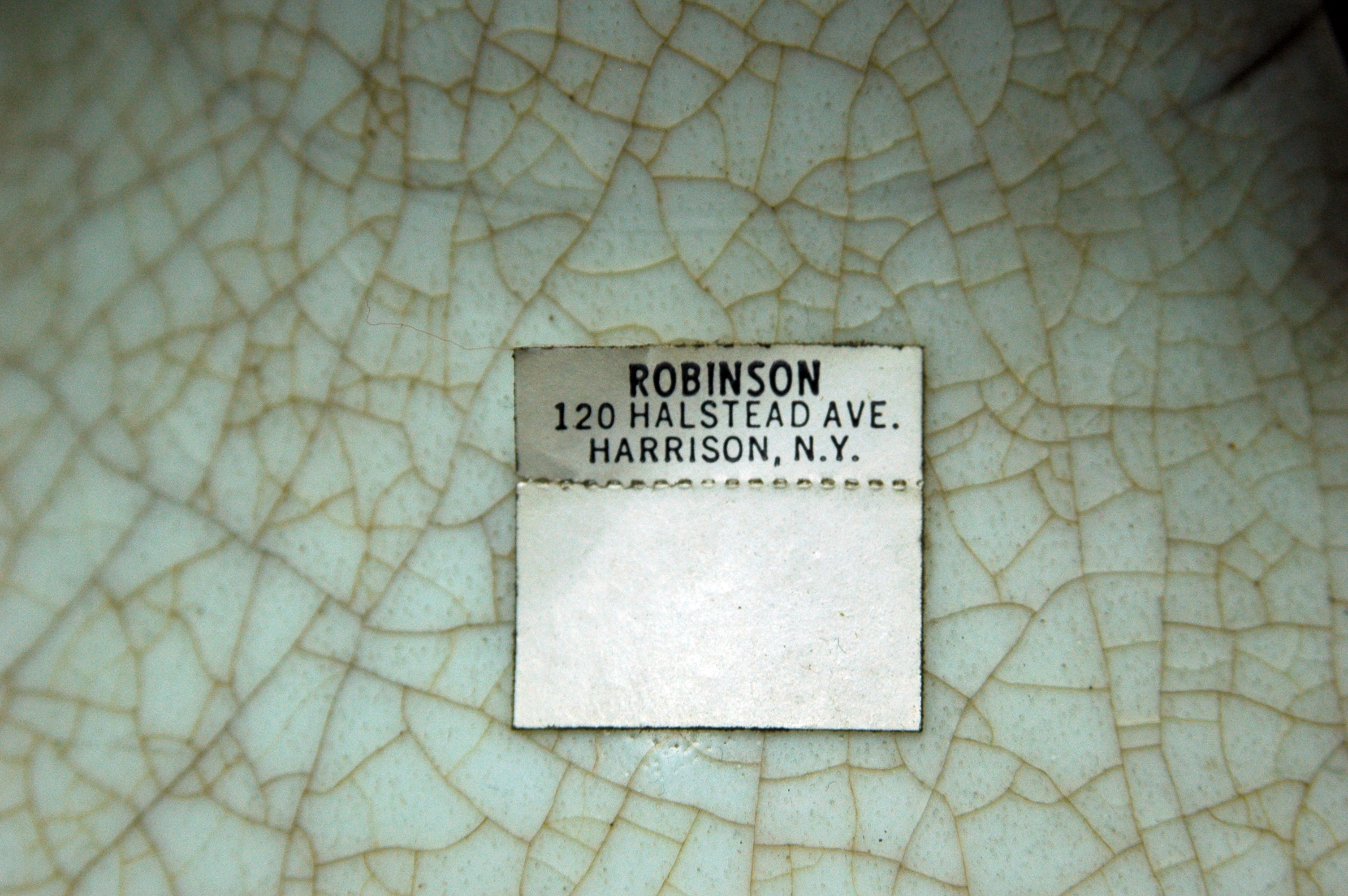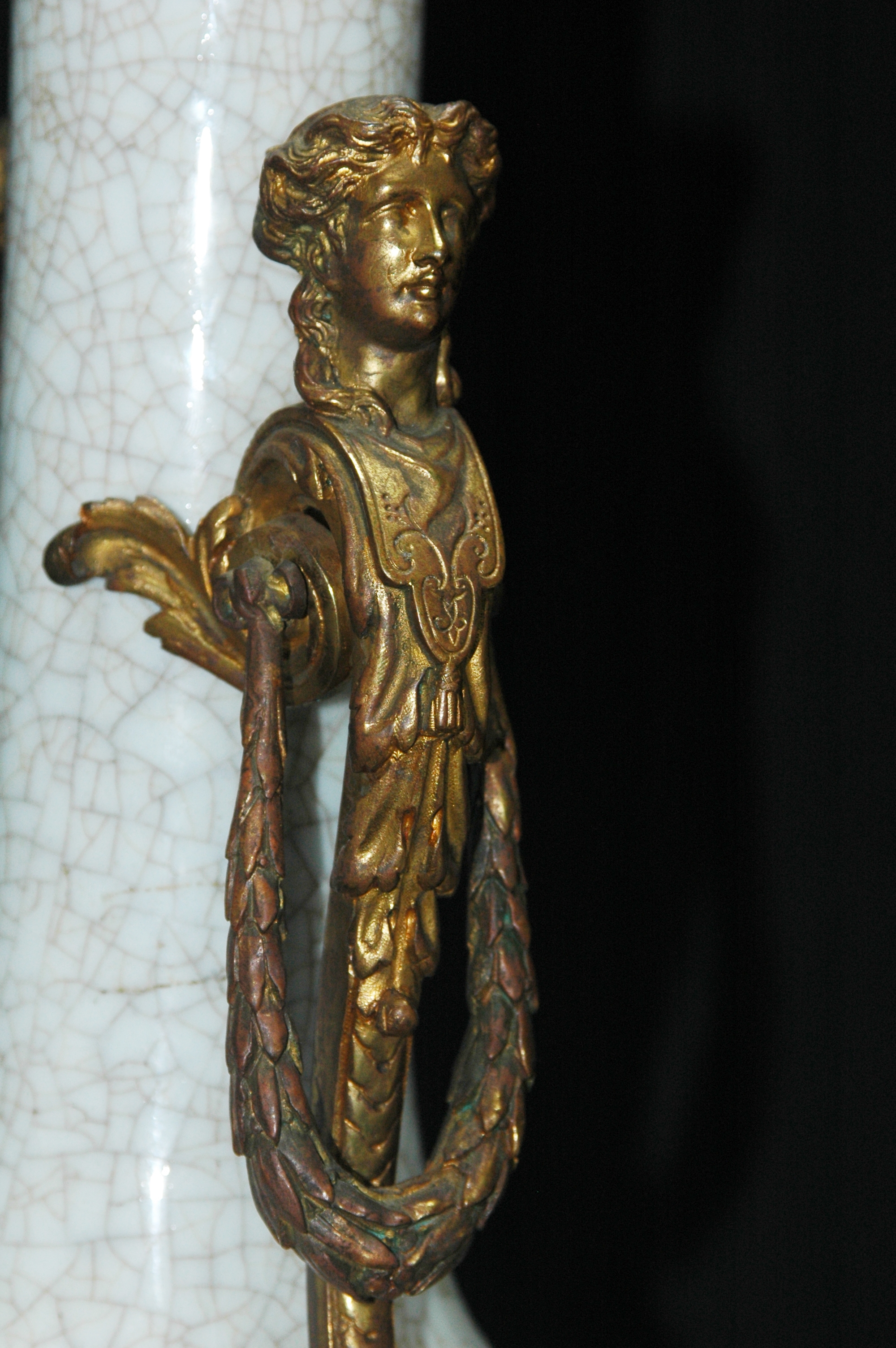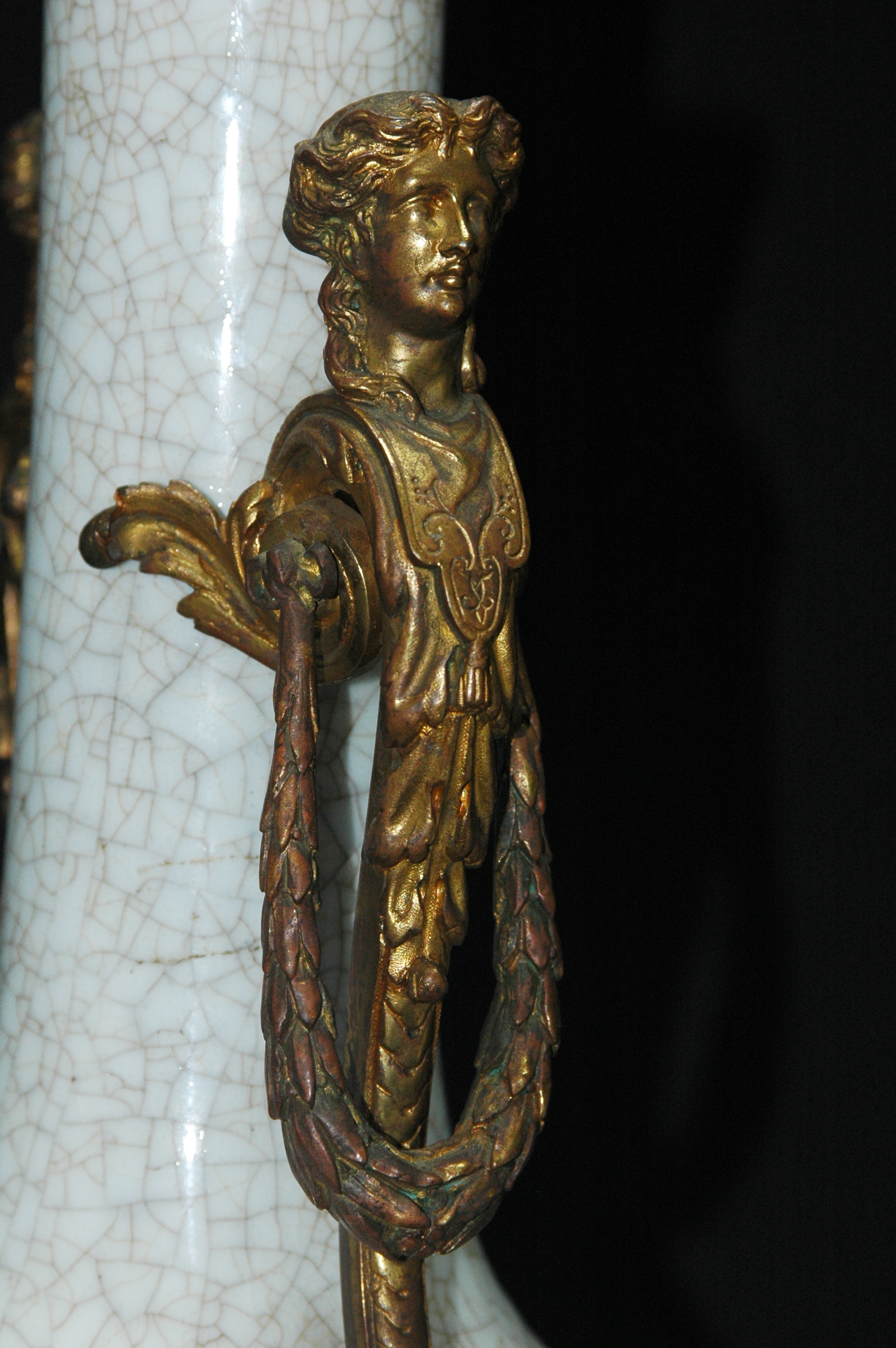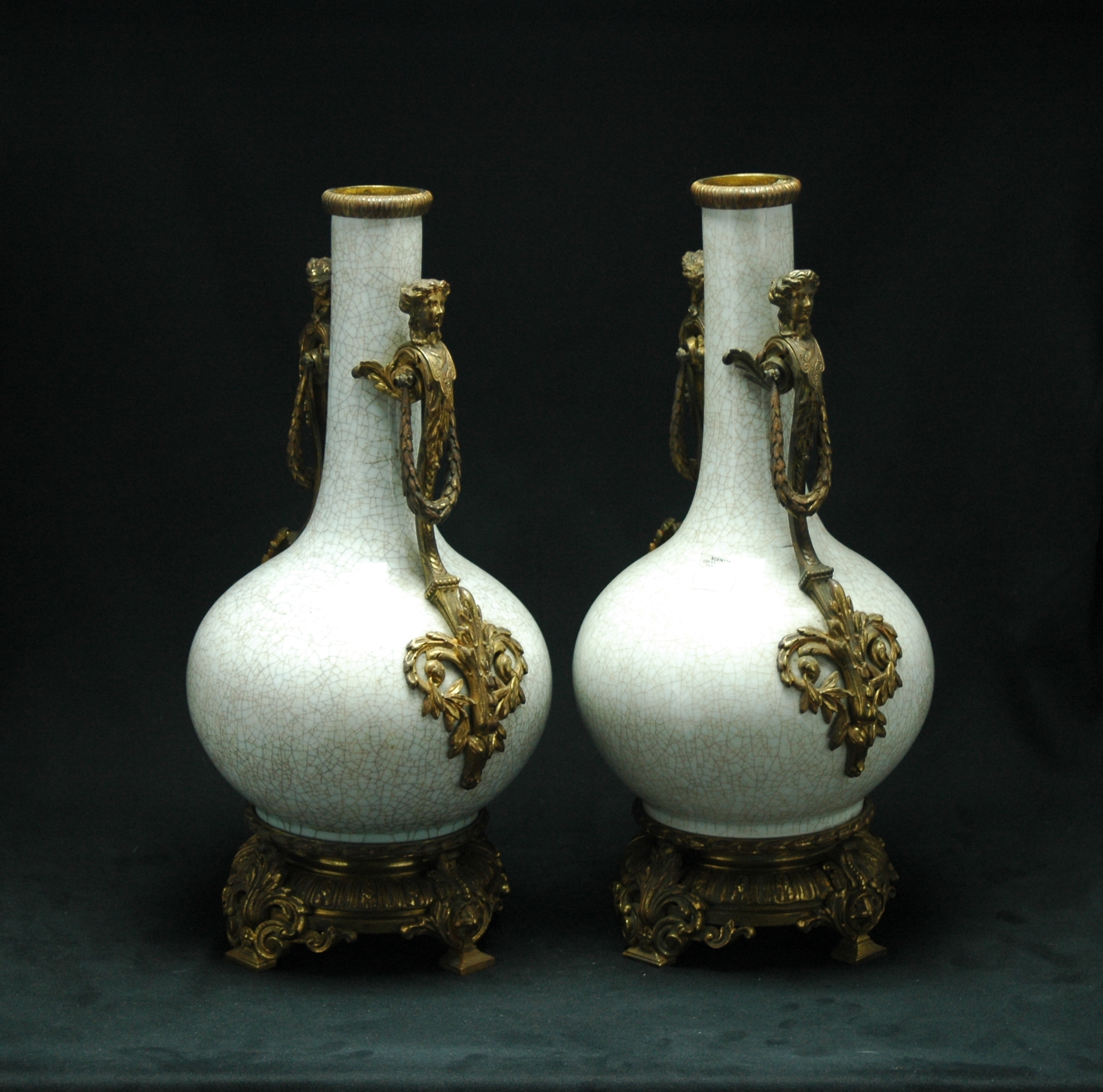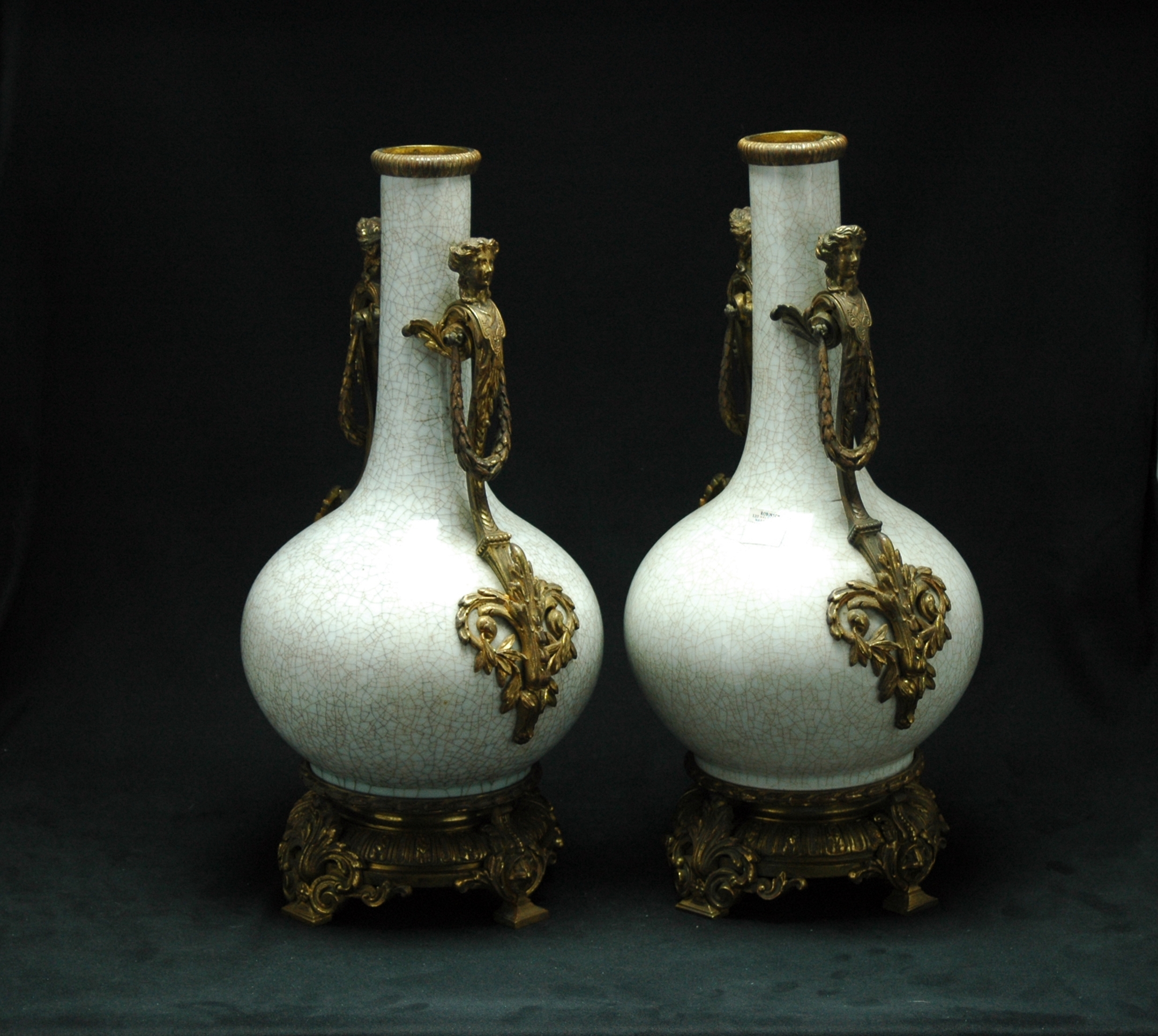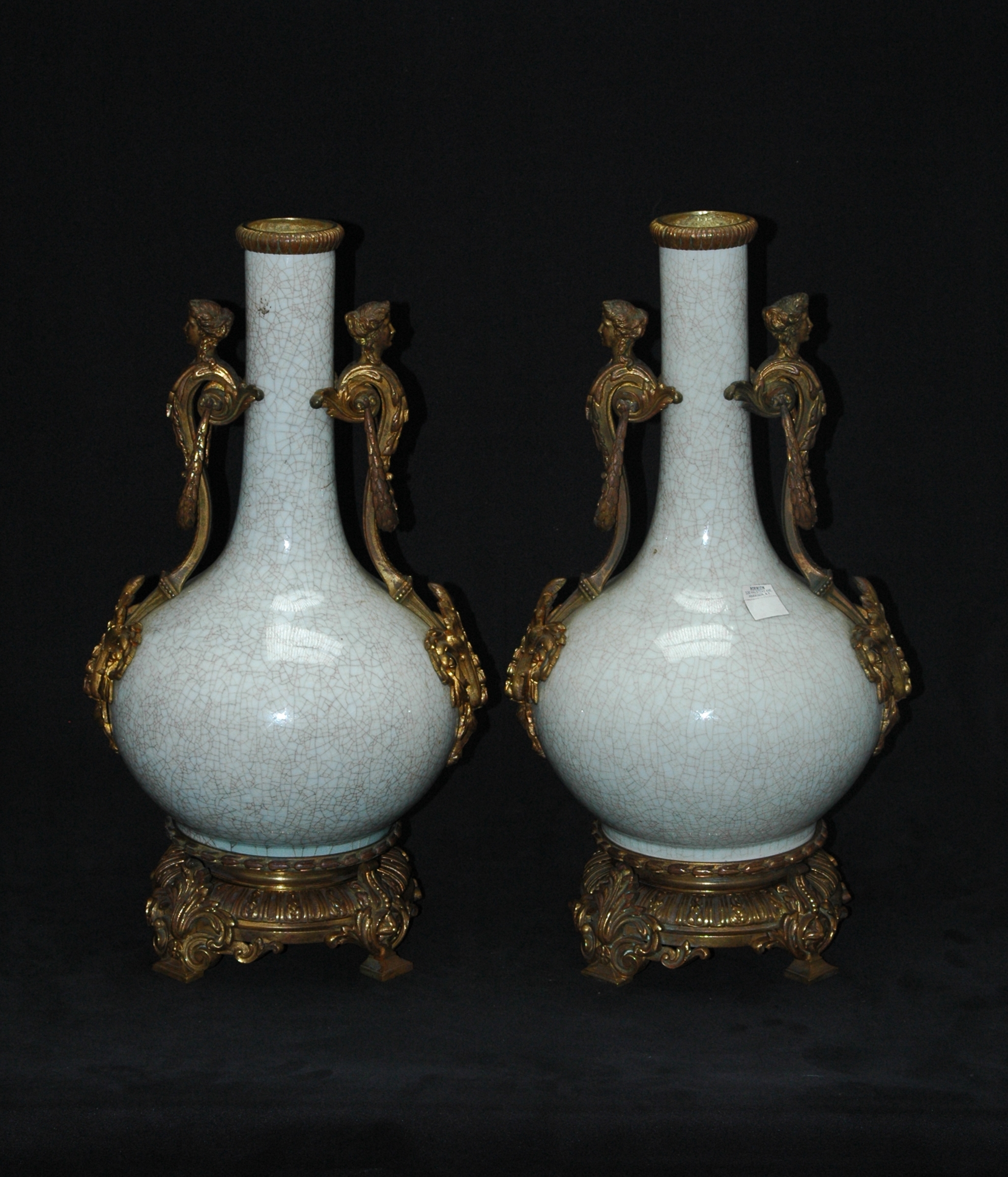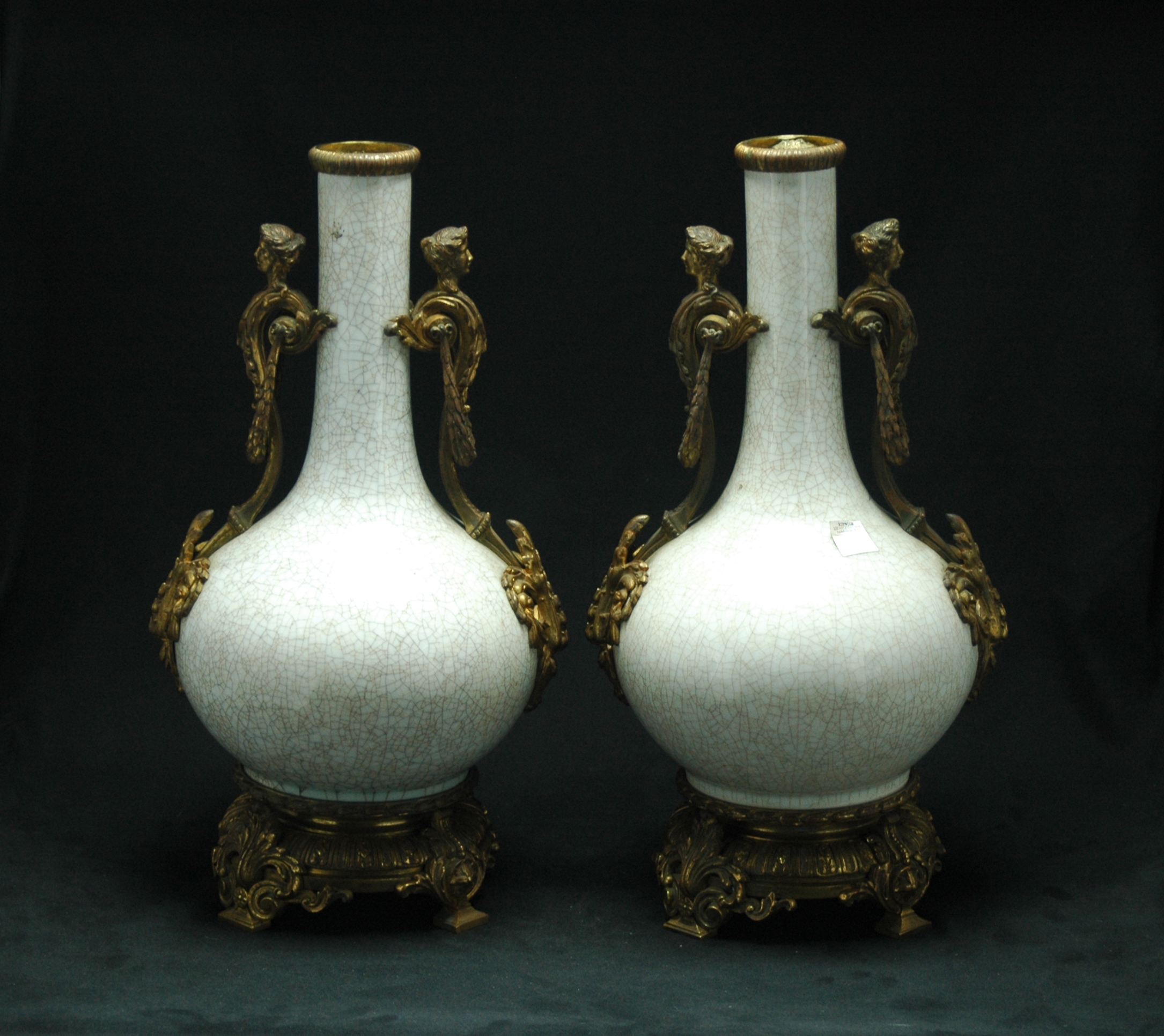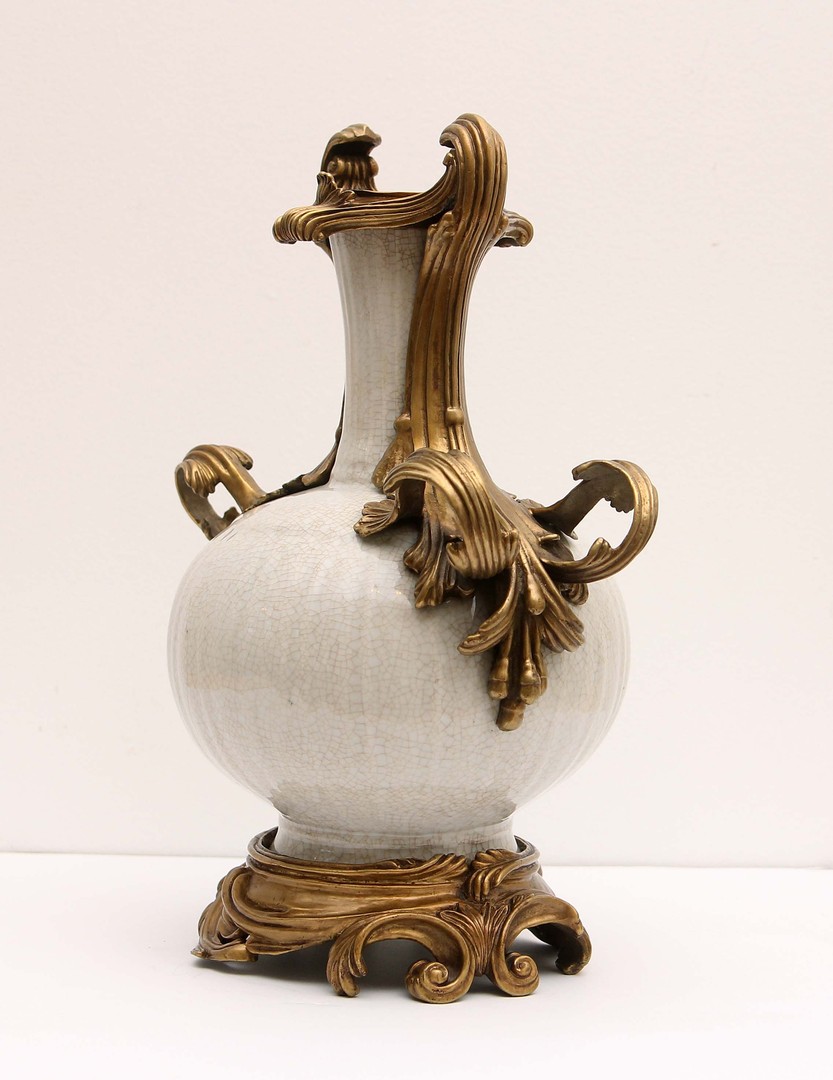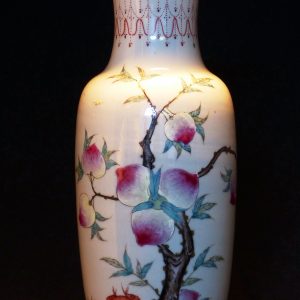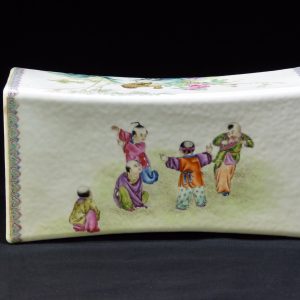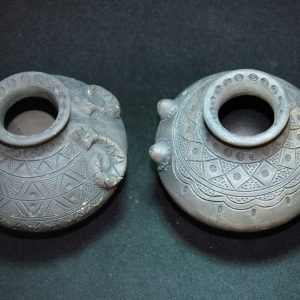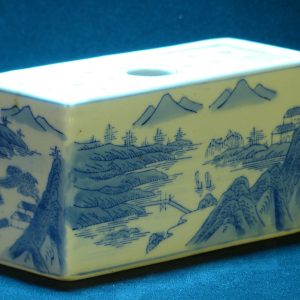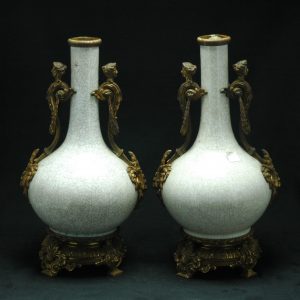Description
大清乾隆 官窑 欧洲法国巴洛克式包铜人物长颈瓶 (对)
参考:
Pair of French Baroque Style Bronze Mounted Celadon Urns
Pair of French Baroque style bronze-mounted white celadon urns, circa 1900.
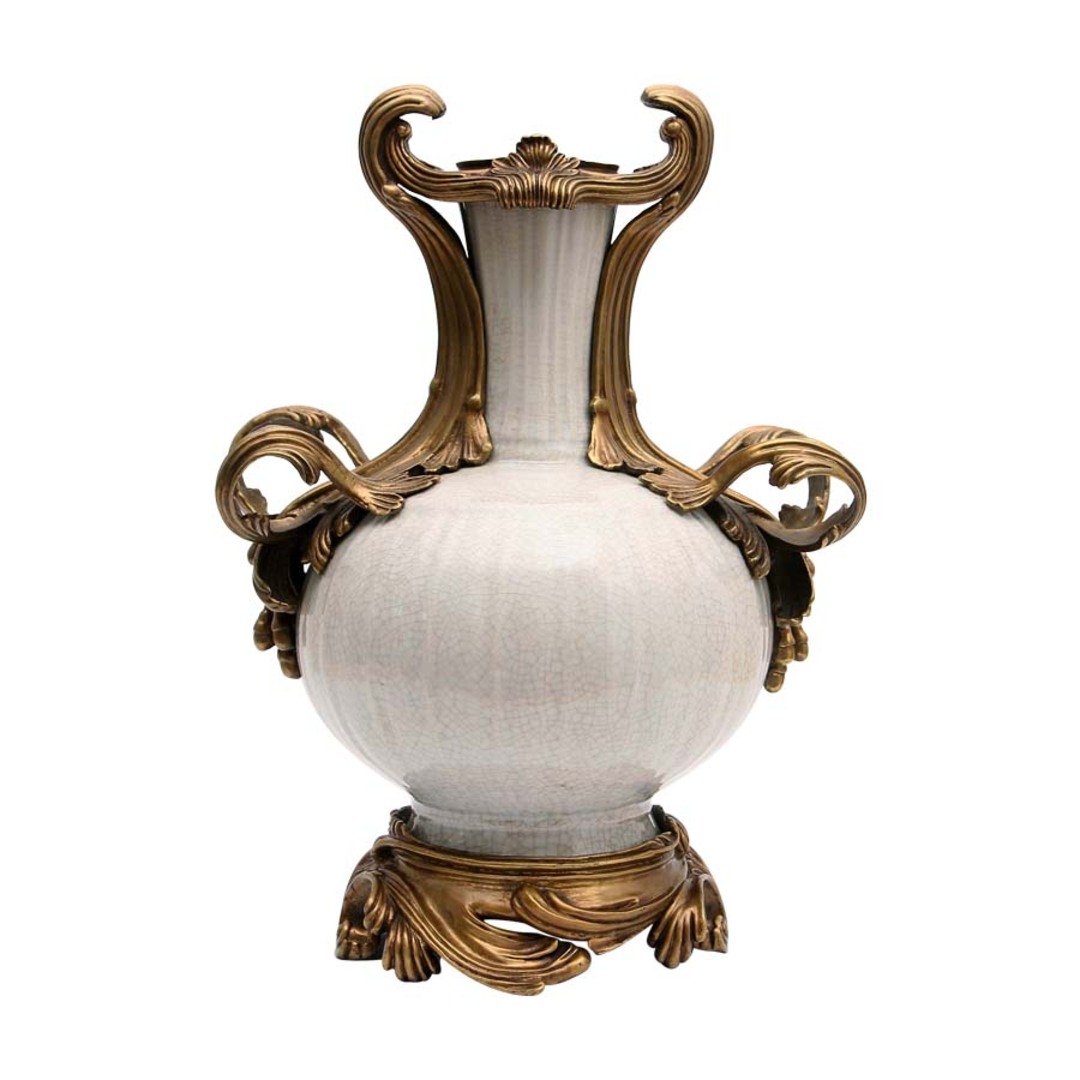
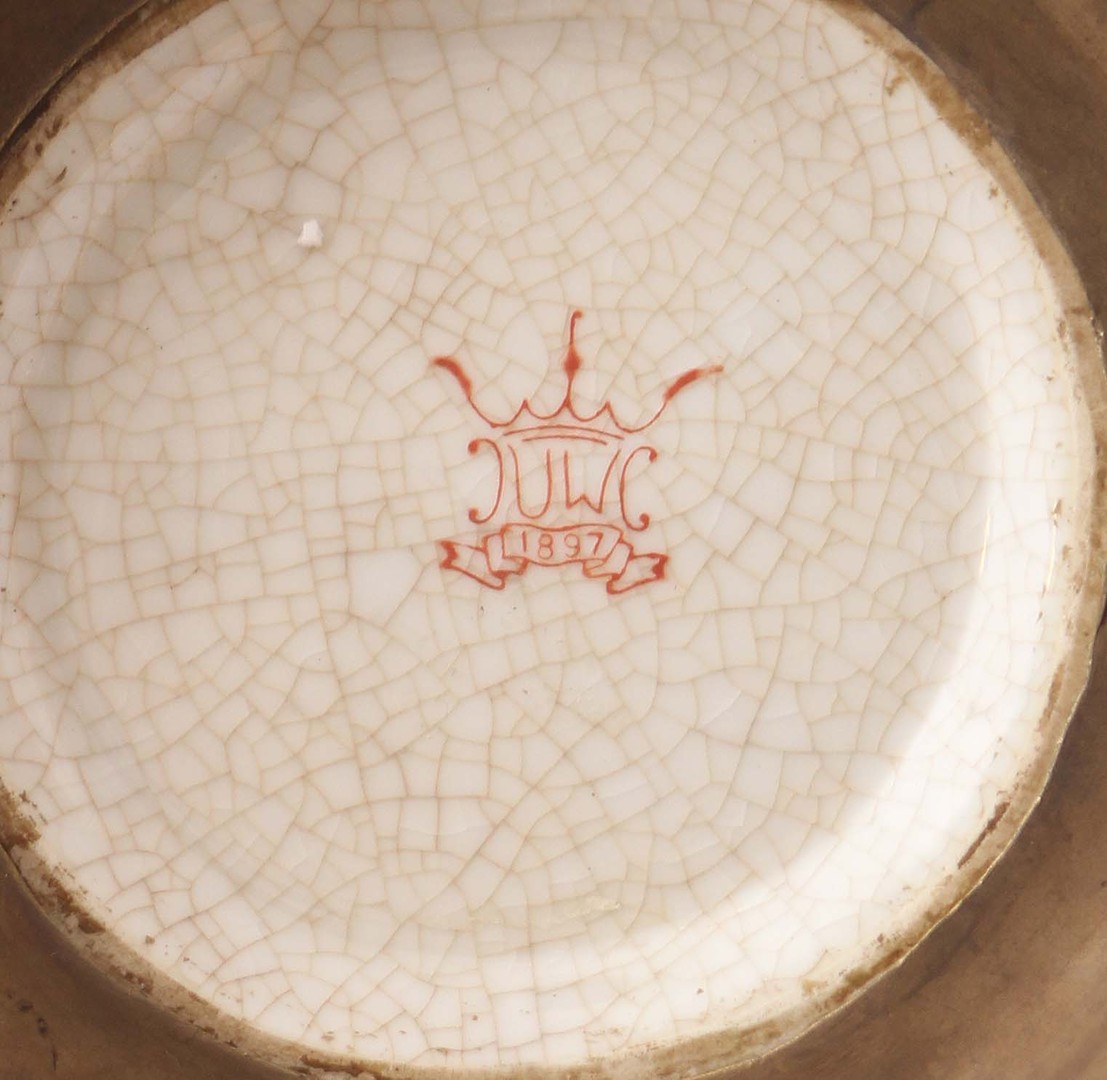
WIDTH: 11 in | HEIGHT: 15½ in | DEPTH: 8 in
ORIGIN:CONTINENTAL
CATEGORY: VASES & URNS
CIRCA: 1900
PERIOD: 19TH CENTURY
STYLE: BAROQUE
CONDITION:EXCELLENT
THB REF: 2471172347
参考:
27 A pair of Louis XV gilt bronze mounted celadon glazed porcelain vases
the porcelain Qing dynasty, early 18th century, the mounts attributed to Jean- Claude Duplessis,
circa 1745-1750
100,000 — 200,000
GBP
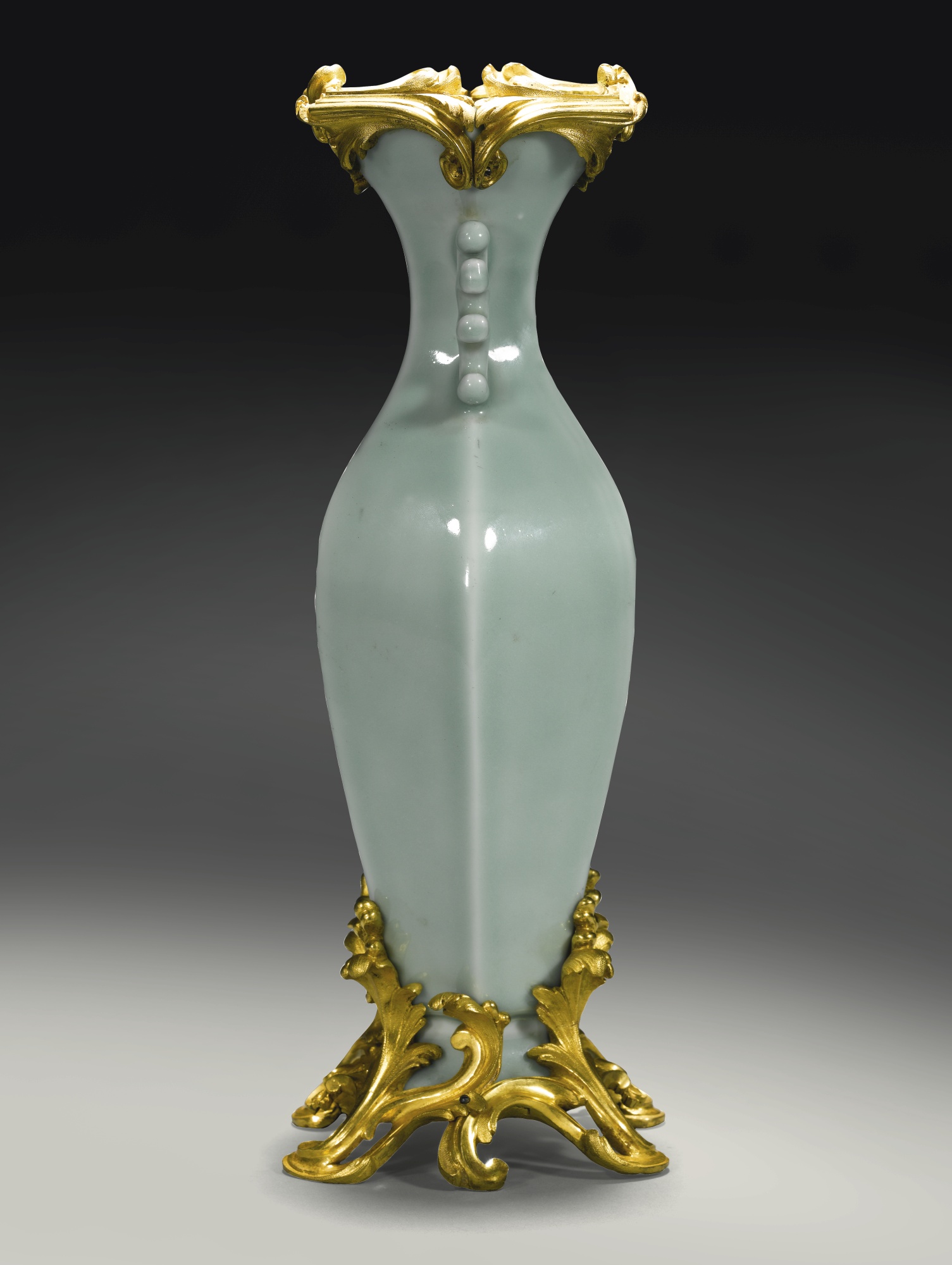
A pair of Louis XV gilt bronze mounted celadon glazed porcelain vases
the porcelain Qing dynasty, early 18th century, the mounts attributed to Jean- Claude Duplessis, circa 1745-1750
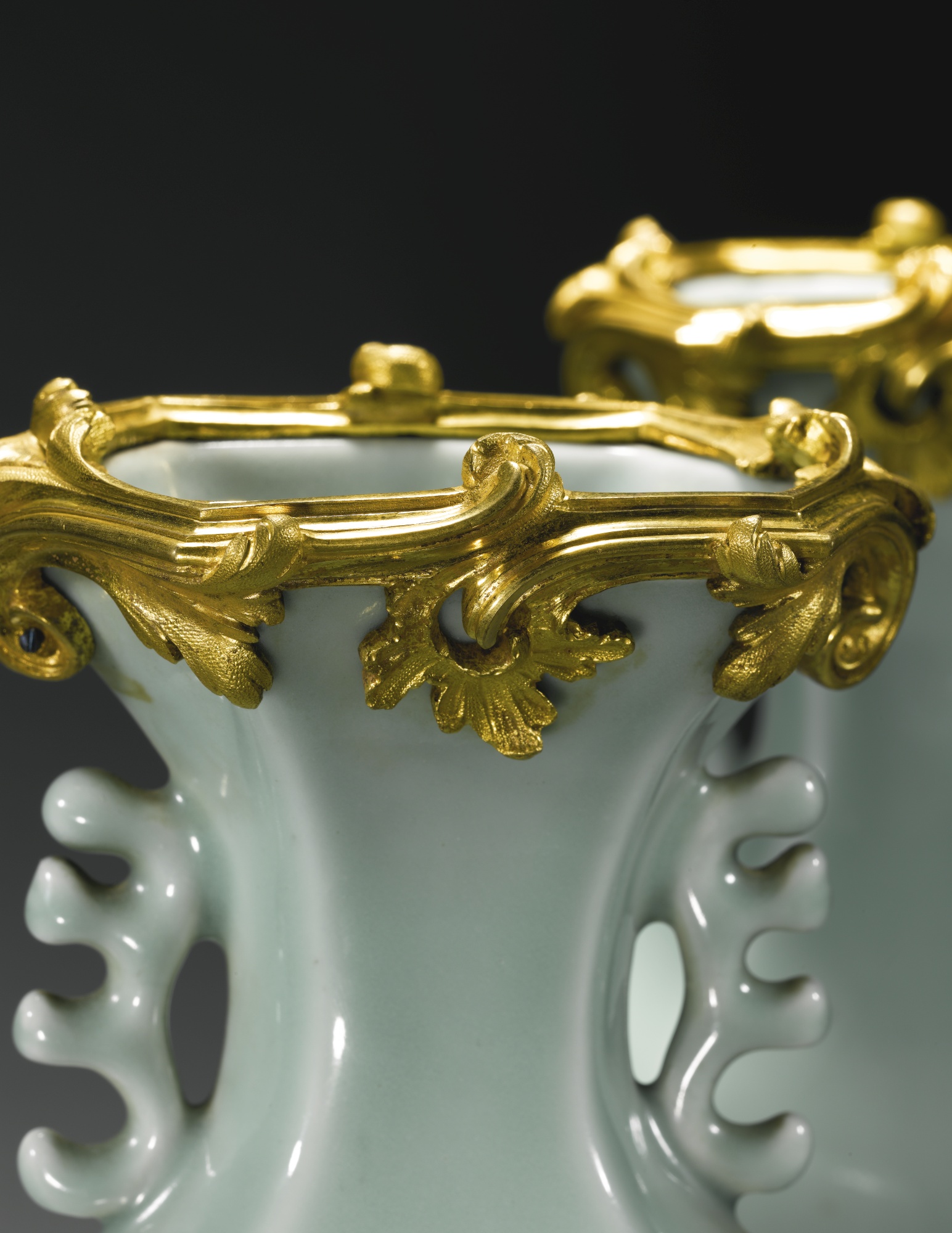
A pair of Louis XV gilt bronze mounted celadon glazed porcelain vases
the porcelain Qing dynasty, early 18th century, the mounts attributed to Jean- Claude Duplessis, circa 1745-1750
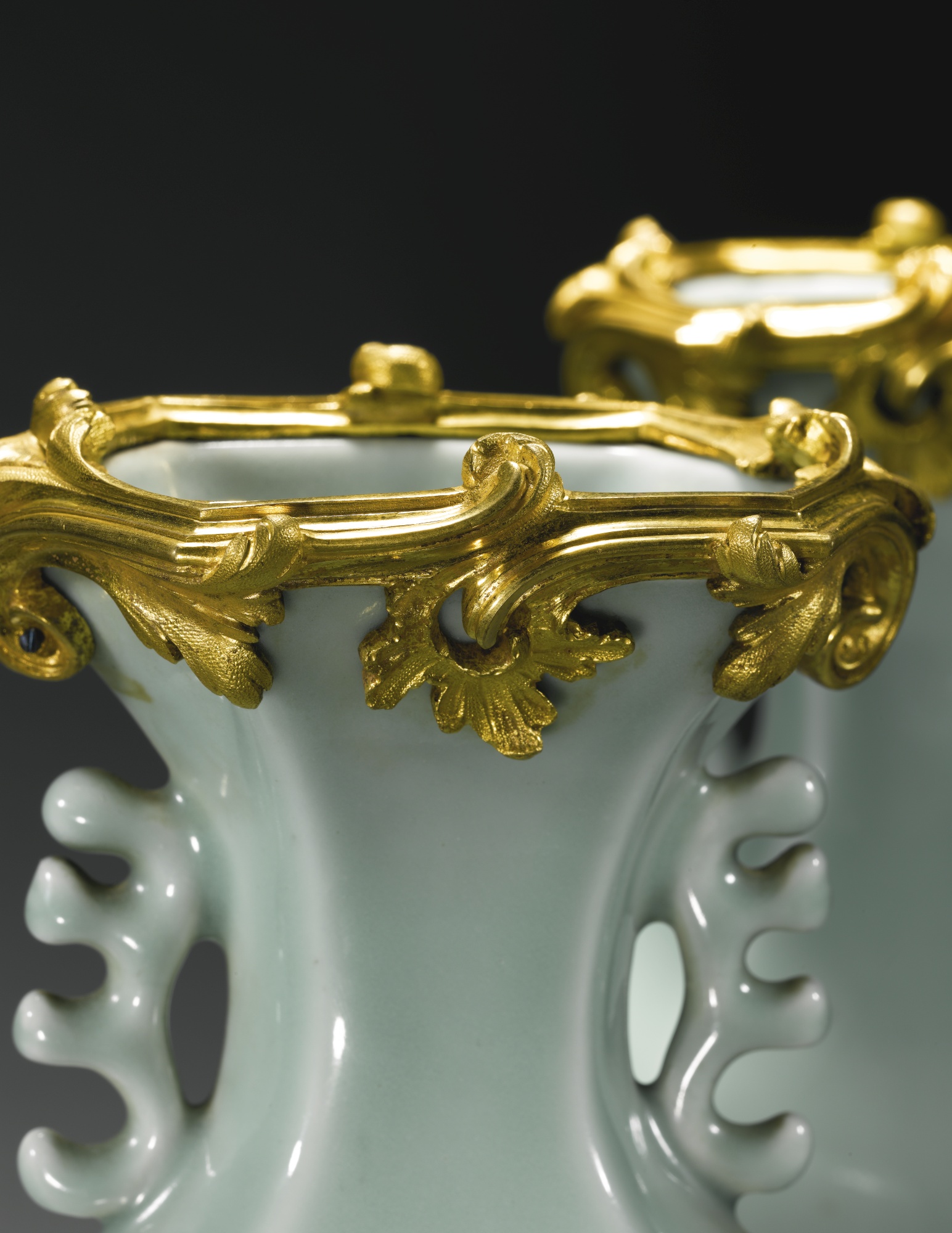
A pair of Louis XV gilt bronze mounted celadon glazed porcelain vases
the porcelain Qing dynasty, early 18th century, the mounts attributed to Jean- Claude Duplessis, circa 1745-1750
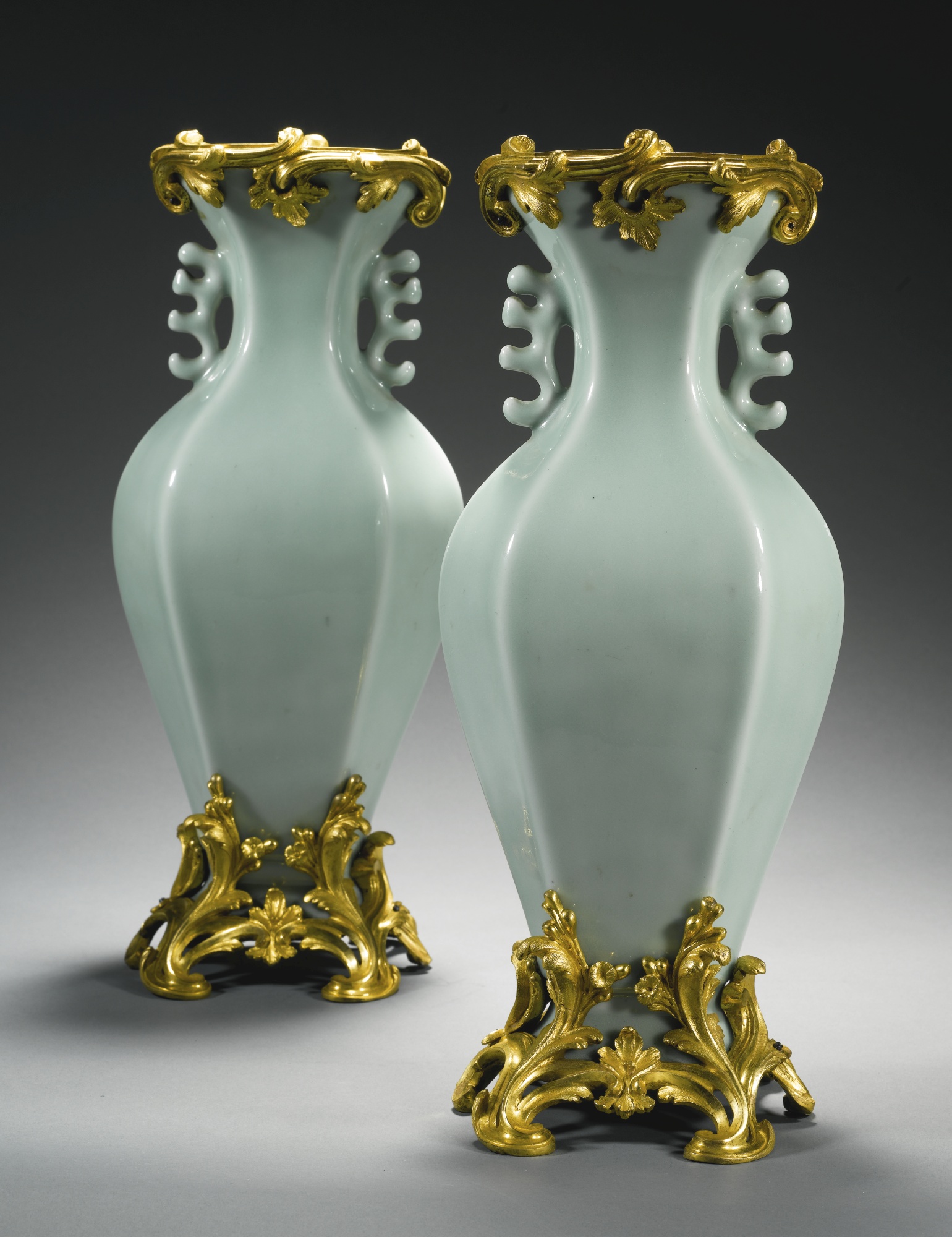
A pair of Louis XV gilt bronze mounted celadon glazed porcelain vases
the porcelain Qing dynasty, early 18th century, the mounts attributed to Jean- Claude Duplessis, circa 1745-1750
the faceted flattened hexagonal body rising from a short spreading foot rising to a tall flaring neck with stylised dragon handles, the finely chased gilt-bronze mounts to the neck with scroll and foliate ornament, the pierced conforming mounts to the base with flowers and berries, each vase with a paper label in manuscript, 47/2
36.8cm. high, 15.2cm. wide, 11.5cm. deep; 1ft. 2½in., 6in., 4½in.
The present pair of vases was originally purchased almost certainly by Edward, Viscount Lascelles (1764-1814) for either Harewood House, Yorkshire or Harewood House, London (fig.1), and thence by family descent until sold by The Right Honourable The Earl of Harewood, Christie`s London, Highly Important Sèvres Porcelain, Chinese Porcelain with French Ormolu mounts and Fine English Furniture, July 1st 1965, lot 47.
Private Collection and then passing by family descent to the present vendor.
Lunsingh Scheuleer, Chinesisches und japanisches Porzellan in europãischen Fassungen, Braunschweig, 1980, p. 318 & 330.Comparative Literature:Gillian Wilson, Mounted Oriental Porcelain in the J. Paul Getty Museum, 1999, pp. 76- 79.Sir Francis Watson, Mounted Oriental Porcelain,1986, p.100
Catalog description
The Collections of the Earls of HarewoodThe present pair of exquisitely mounted vases formed part of the magnificent collection of gilt-bronze mounted Chinese porcelain originally collected by either Edward Lascelles, 1st Earl of Harewood (1739- 1830) or more likely by his son and heir Edward, Viscount Lascelles, most probably for Harewood House, Hanover Square, London and subsequently moved to Harewood House, Yorkshire.The Lascelles family originated in Yorkshire. In the late 17th and early 18th century they acquired significant sugar plantations in Barbados, the profits of which enabled Edwin Lascelles, 1st and last Baron of Harewood (d. 1795) to build the magnificent country house named Harewood House, in Yorkshire. Designed by Robert Adam and with furniture by Thomas Chippendale, which was to be one of his greatest commissions, the house was then and indeed is now still considered to be one of the greatest houses and collections of England. The estate passed from Edwin Lascelles on his death, to his cousin Edward, who in 1812 became 1st Earl of Harewood. His son and heir was Edward, Viscount Lascelles.In 1795 the Lascelles family also acquired as a town house, Harewood House, London which was on the north corner of Hanover Square, London. Originally named Roxburghe House and designed by Robert Adam, the family engaged the architect Samuel Page to alter it to their taste. It remained occupied by the family until 1895 and was demolished in 1908.Viscount Lascelles was known as a great art connoisseur and collector (fig.2). Nicknamed ‘Beau’ because of his physical resemblance to the Prince Regent, he patronised the celebrated London dealer Robert Fogg who was based in both Regent Street and Golden Square. Fogg specialised in supplying furniture and ceramics and in fact rather charmingly described himself as a `Chinaman’. He supplied distinguished collectors which included the Prince Regent and also William Beckford and accounts show that he supplied both Viscount Lascelles and the Earl of Harewood with Chinese porcelain. He supplied Viscount Lascelles in 1807 with ` a pair of sea green China jars’ for £600 (Mary Mauchline, Harewood House, London, 1974, p.117). Accounts for 1807 show that 1ST Earl spent £1400 with Fogg. As clearly Fogg dealt with ceramic pieces of the quality of the present lot, it would seem likely that he also supplied the present vases.
Many of the French mounted porcelain pieces in the Harewood House collection were probably originally owned by distinguished French aristocratic patrons who had fallen to the guillotine and whose possessions subsequently appeared in the Paris salerooms in the revolutionary sales of the late 18th century. England was of course at war with France and it was difficult for collectors or agents to travel to France. However the Peace of Amiens in 1802 temporarily enabled English collectors to visit Paris and it is thought that this was when the present vases were acquired and brought to England.
The Lascelles family seem to have had a particular passion for porcelain of this type as an inventory of 1838 of Harewood House London shows that there were ninety seven pieces of Chinese porcelain described as `Green’ or `Mandarin’ and fifteen pieces of ormolu-mounted Chinese porcelain. The porcelain was eventually transferred to Harewood House Yorkshire where it remained until selected pieces were sold in 1965 by 7th Earl of Harewood (d.2011). The collecting tradition and connoisseurship of the family continued into 20th century.The 6th Earl of Harewood who was the father of 7th Earl, (d.1947) married Her Royal Highness, The Princess Royal, Princess Mary, only daughter of H.M. King George V and Queen Mary. They were to carry out much restoration, refurbishment and re-organistion of the house and its collection which included re-hanging pictures, re-upholstering the Chippendale furniture and re-arranging it in the manner in which it was intended to be displayed. The 7th Earl continued this work which included the restoration of the magnificent gallery to its original state, where much of the remaining Chinese gilt-bronze mounted porcelain still remains, (see fig.3). Taxation during the sucession of the 7th Earl necessitated sales of works of art and land, however such was the scale of the collection that much still remains to make it one of the most exceptional collections in the country.
The Porcelain
According to Kristal Smertek in Rococo Exotic French mounted porcelain and the Allure of the East, New York, 2007, quotes Jean Baptiste de Boyer, Marquis d`Argens in his Chinese Letters between 1739 to 1740 `The French do not have any aversion for foreign culture, which they adopt easily, but the thing is they like to add or remove things to it, that`s what we call `le gout francais’. This comment perfectly encapsulates the history of the fashion for mounted porcelain in France. The enthusiasm for this type of of exotic porcelain commenced with the various `Compagnie des Indes’ which from the 17th century onwards, traded with the Orient in all manner of luxurious Oriental ware which so inspired the Parisian marchands-merciers who were driven to supply their illustrious clientele with the latest fashion and novelties such as gilt-bronze mounted objects. As soon as the Oriental ware arrived in Europe, the rarest pieces were cut, carved or even associated, before being applied with gilt-bronze mounts.
The present vases are Celadon porcelain, which is also called greenware has an olive green feldspathic glaze obtained through the high firing ( minimum 1,200c) of iron oxides which are applied directly onto the earthenware body. Chinese celadon is usually classified in two types; Northern and Southern. Northern celadon was mainly made during the Song dynasty but not after that when its capital moved South in 1127 and does not seem to have been exported. Southern celadon was made through the Song dynasty and later. This type of celadon was widely exported and thus is mainly found in European gilt-bronze mounted objects such as the present vases. The large size of the present vases and rather unusual handles are characteristic of the type of Chinese ceramics that were made for the European market. The glaze relates to the celebrated Longquan wares of the Song dynasty and the form of the present vases is reminiscent of contemporary Imperial vessels.
The Mounts
The gilt-bronze mounts on the present vases are heavily scrolled and foliated with berries that scroll upwards on the base. They have been attributed to Jean-Claude Chambellan Duplessis (d. 1773) on stylistic grounds and also on the basis of their exceptional quality. The bronzes are extremely finely cast and clearly specifically cast for the present vases as they follow the form of the vase. They are also extremely well executed in terms of burnishing with polished and matt areas of chasing which are conceived to contrast and highlight the detail. Duplessis, born in Turin, was the son of the sculptor, bronzier and artistic director of the Vincennes-Sèvres Manufactory. From 1752, he assisted his father in creating models and is best known for his work as a designer and modeller for the Sèvres factory. On 12th June 1765 he became maître fondeur en terre et sablehaving mastered the disciplines of drawing and sculpture. In 1777 he was described in the Almanach des Artistes as a `bondessinateur, travaille d`après ses dessins`. He became the appointed bronzier to the Sèvres factory and was replaced after his death by Pierre-Philippe Thomire. Although he seems to have also worked extensively for the marchands-merciers as a sculptor of decorative bronzes, there is very little documented work by him. He is however known to have made the mounts for the bureau du Roi Louis XV at Versailles and also those for a Sèvres vase given by the Dauphine, Marie-Josephe de Saxe to her father Augustus III, King of Saxony, in 1749.
Gilt-bronze mounted porcelain was at the pinnacle of fashion in France during 1750s being supplied by such marchands-merciers as Lazare Duvaux. His day book records numerous purchases of this porcelain by the leading collectors of the day. The Marquis de Voyer d`Argenson ( Livre-Journal de Lazare Duvaux 2 vols. Ed. L. Courajod, Paris 1873, p. XXXIII) achetait surtout chez Duvaux de la porcelain Céladon garnie de pieds et et de montures de bronze doré. Plus souvent, possesseur de pieces de choix, il chargeait Duvaux de les monter. Celui-ci le nuit en rapport avec le celebre modeleur Duplessis…D`Argenson`s most ambitious purchase of celadon is recorded in September of 1750, ( no. 601): Deux gros vases de porcelain doré d`or moulu 3000l. The only other purchase of celadon by a contemporary collector of a similar value is made by Gaignat de Gagny who bought in 1754: Deux urnes de porcelain Céladon, couvertes, montées en bronze d`ormolu par Duplessis, 2920l. Other references include in 1754 a reference to the Marquise de Pompadour: `La garniture en bronze d`oré d`or moulu d`un vase en hauteur de porcelain celadon a tete de belier, nouveau modèle du Duplessis 320l; These sums represented very considerable sums and indicate the esteem in which such items were held.
For comparison a single vase of identical form to the present pair of vases is in the collection of the J. Paul Getty Museum and is illustrated in Gillian Wilson, Mounted oriental Porcelain in the J. Paul Getty Museum, 1999, p.76, figs. 15A-15C. This example had a provenance of the Trustees of the Swinton Settled Estates, sold Christie`s London, 4th December 1975, lot 46. Another related pair of vases to the present pair is in the Musée Nissim de Camondo, Paris, (accession number 222). Another example of French gilt-bronze mounted Chinese porcelain, the mounts attributed to Duplessis can be seen in a vase and cover in the collection of the Museum of Fine Arts, Boston, Forsyth Wickes Collection, ( 65.2262 a-b), illustrated in Sir Francis Watson, op. cit., pp.26-7. See also a large Louis XV period celadon vase with gilt-bronze mounts attributed to Duplessis, sold Sotheby`s Paris 23rd June 2004, lot 58. An exceptional garniture of three gilt-bronze mounted Chinese blue porcelain vases, the porcelain Kangxi (1662-1722), the mounts Louis XV, circa 1755-60, attributed to Jean-Claude Duplessis, lot 37, sold Sotheby`s Paris, the Collection of Leon Levy, 2nd October 2008, lot 37, inc. premium 1,151,150 Euros. A Loius XV ormolu-mounted Chinese Clair-de-lune porcelain vase, the mounts also attributed to Duplessis, and with same provenance as the present lot was sold Christie`s London, Collecting in the Royal Tradition, 5th December 2012, lot 29, sold incl. premium £1,161, 250.
参考:
Pair of Impressive French Gilt-Bronze Mounted Vases
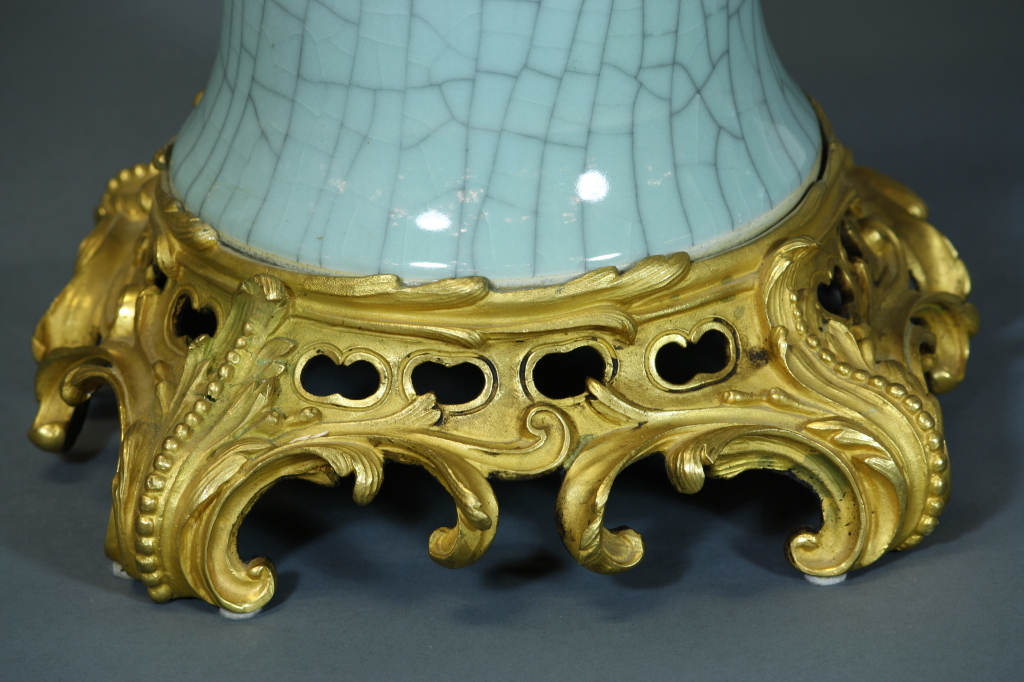
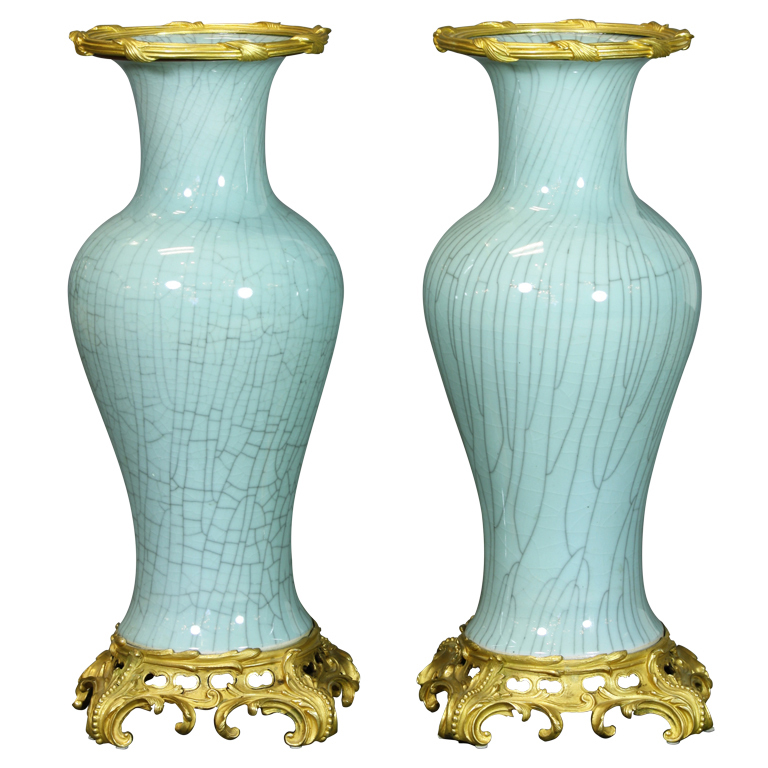 A large nicely-cast gilt-bronze mounted Chinese celadon vases in the Louis XV style, with faux crackle patterning and gilt-bronze rims. Unknown mark on the bottom of the vases.
A large nicely-cast gilt-bronze mounted Chinese celadon vases in the Louis XV style, with faux crackle patterning and gilt-bronze rims. Unknown mark on the bottom of the vases.
PRICE: $12500 Sold
PLACE OF ORIGIN: France/China
DATE OF MANUFACTURE: Late 19th century
PERIOD: 19th Century
MATERIALS AND TECHNIQUES: Porcelain vases, gilt-bronze mounts
MATERIALS NOTES: Porcelain vases, gilt-bronze mounts.
CONDITION: Very good overall condition with minor crackling of glazed finish on vases and minor wear to gilding, all consistent with age.
HEIGHT: 23 1/2
DIAMETER: 9 in. (23 cm)
DEALER LOCATION: Boston, MA
NUMBER OF ITEMS: 1
REFERENCE NUMBER: U1210288385372
外销瓷市场行情
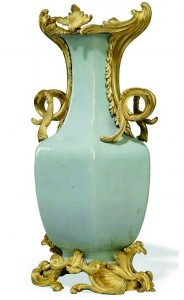
乾隆粉青釉六棱瓶
在近日伦敦举行的艺术品拍卖会上,一件乾隆粉青釉六棱瓶,外包路易十五时期风格铜装饰的清代外销瓷,估价30万英镑至50万英镑,最终以116.1万英镑成交。近年来,外销瓷在市场上出现高价也不是新鲜事,这些带有异域风情的外销瓷无疑成为艺术市场一道独特的风景线。
精品外销瓷创天价
外销瓷特指中国历史上那些以对外贸易为目的而生产销往海外的瓷器,多是明清时期由陆路、海路运出或由外商来我国收购、定制等经营方式而销往国外的。
抵达欧洲的第一批中国瓷器或是中国式样,或是按照亚洲的市场需求设计的。约在1700年,欧洲各东印度公司都向中国订购大量欧洲风格的瓷器,其中一些是对欧洲原器物的仿制或改造。这些瓷器不仅包括仿自欧洲的各种陶瓷餐具,如餐盘、甜点篮、酒碗等,还包括更多用来装饰餐桌的瓷雕艺术品。
外销瓷交易最早是从“海捞瓷”拍卖开始。2007年1月29日至31日,苏富比(微博)在荷兰首都阿姆斯特丹拍卖了从越南海域打捞上来的约7.5万件中国清代青花瓷,引起了全球收藏家的关注。为期3天的5场拍卖会取得300万欧元的总成交额,高出之前200万欧元的最高估价。
然而,由于绝大多数“海捞瓷”是作为日用瓷而烧制的,品位都不高,这无疑让许多人都误解了外销瓷的价值。事实上,在拍卖市场上,精品外销瓷的天价并不少见。2011年7月7日,美国赌场大亨斯蒂芬·韦恩在伦敦佳士得拍卖会上以7400多万元的高价买走了18世纪嘉庆年间的4件套瓷瓶。而一对采用巴洛克式装饰风格装饰后的康熙粉彩包铜装饰盖罐,成交价也达到110多万元。
市场由冷转热
随着近年来水下考古的蓬勃发展,许多沉船被打捞出来,大批外销瓷纷纷“浮出水面”。1983年,英国人麦克·哈彻在南中国海发现了300多年前沉没的中国明代帆船,船内满载2万余件瓷器,虽经海水长期侵蚀和冲撞,但出水时依然光洁照人。在荷兰阿姆斯特丹拍卖时,这批瓷器以250万美元成交,平均每件价值112美元。上世纪90年代末,普通的青花碗只要50美元、康熙青花盘大约100美元,这与当时的官窑瓷器市场有着天壤之别。
但在最近几年,情况已有很大变化。2005年,在纽约佳士得的拍卖会上,一对带有菲利普五世纹章图案的外销瓷以245.76万美元成交,在当时创下了外销瓷拍卖纪录。在2012年伦敦苏富比的拍卖会上,一件是清嘉庆外销葡萄牙青花瓷以358.7万元成交,该瓶具有鲜明的外销瓷特征,瓷器的上部有葡萄牙文,还配有一个合金的瓶盖。另一件明早期外销到伊比利亚的青花长颈瓶,以311.3万元成交,这两件外销瓷器的高价成交预示了外销瓷器价格的新空间。
在内地拍卖市场上,中国嘉德(微博)在2005年首开外销瓷拍卖专场,214件外销瓷一共拍得270万元。其中,明万历青花莲瓣形开光花鸟盘估价2.6万元,成交价达到5.5万元,这较以往已经有了很大的飞跃。
近年来,随着大量海外文物的回流,广彩瓷逐渐为人们所了解和熟悉,其市场行情逐步得到提升。在中国嘉德、北京翰海举办的拍卖会上,广彩瓷多以较高价格成交。比如,在2001年7月北京翰海拍卖中,一件光绪广彩开光人物碗以15.4万元成交,2010年12月在中国嘉德再次上拍时以22.4万元成交。2010年6月,一对广彩人物纹大瓶估价28万元,最终以42.5万元成交,
价格优势值得关注
对于普通投资者而言,一些中低档外销瓷存世量很大,价位仅数千元,既可以作为收藏投资的对象,又可以作为艺术品来装饰家庭。比如欧洲市场上常见到的清三代粉彩外销瓷,用料较好,画工精细,大多带有欧洲风格的纹饰,且大量存世,易于投资,而同一时期为国内生产的青花瓷器价位则在几万元。相较而言,外销瓷价位很低,投资此类瓷器正当其时。
对于具有一定实力的投资者来说,则可以关注外销瓷精品,虽然价格达到几十万元至百万元之间,但相对于精品官窑,还是显得相当“便宜”。比如印有纹章的“纹章瓷”,虽然在外销瓷中的比重不大,但却是最为精美的。因为多为贵族、皇室成套定制,他们不仅出高价,要求也最为严格,因此从目前的拍卖市场的情况来看,这类瓷器往往能够拍出高价。同时,广彩瓷中的那些绘画精彩的品种也可以重点关注。
参考:Mounted vase
Robinson Galleries Inc
120 Halstead Ave
Harrison, NY 10528
United States
Phone number(914) 835-1843
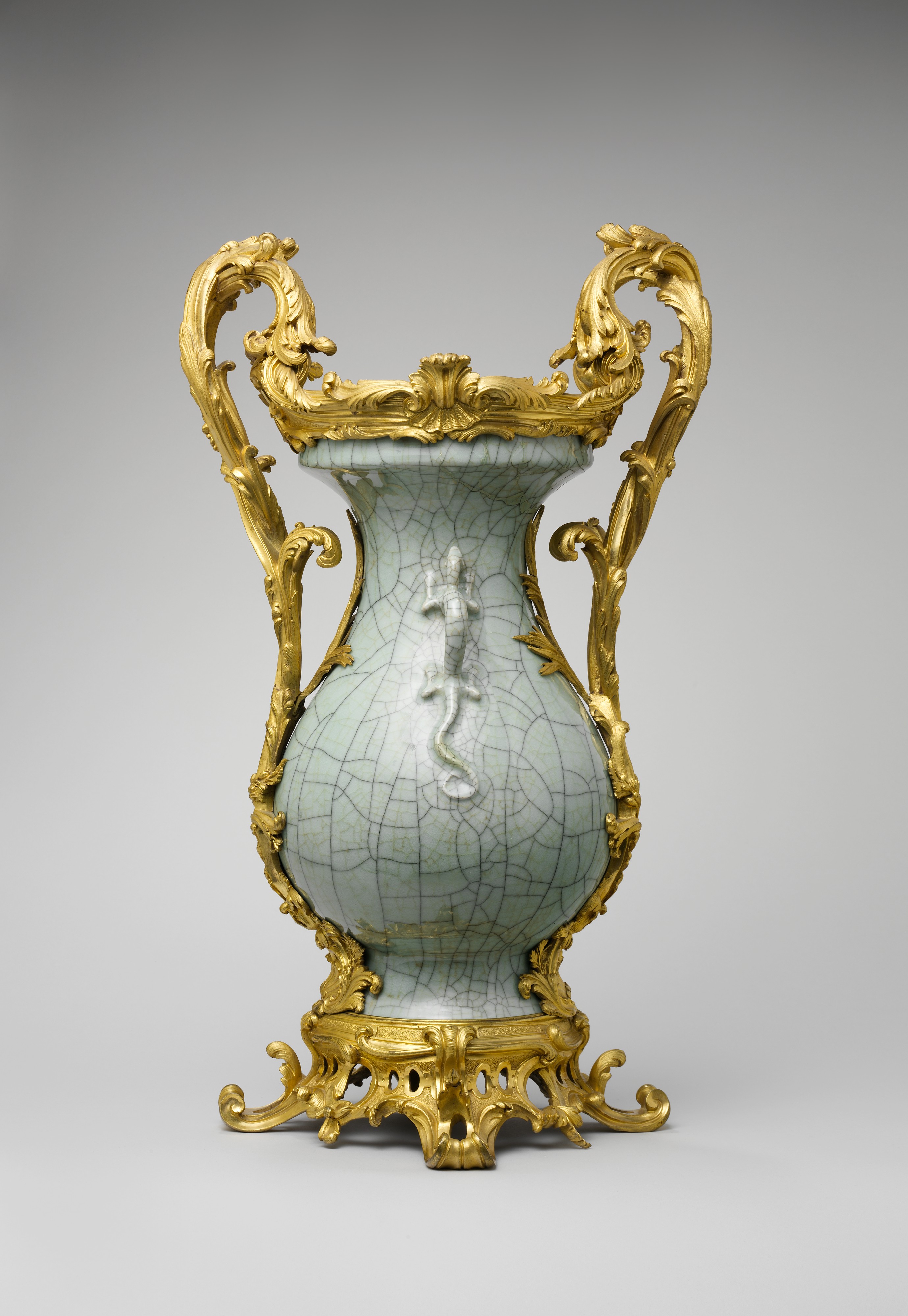
Date: porcelain early 18th century, mounts ca. 1750
Culture: Chinese with French mounts
Medium: Hard-paste porcelain; gilt-bronze mounts
Dimensions: H. 23 3/8 x W. 13 3/4 x D. 12 1/2 in. (59.4 x 34.9 x 31.8 cm)
Classification: Metalwork-Gilt Bronze
Credit Line: Gift of Mr. and Mrs. Charles Wrightsman, 1971
Accession Number: 1971.206.22
On view at The Met Fifth Avenue in Gallery 525
With delight one notices . . . a very large number of pieces of old porcelain of the greatest perfection, [and] the mounts that accompany the pieces seem to rival them in value.
— Antoine-Nicolas Dézallier d’Argenville, Voyage pittoresque de ParisIn eighteenth-century France, gilt bronze played important functional and decorative roles in the houses of those who could afford it. Gilt bronze was employed for andirons, furniture hardware, wall lights, candelabra, and chandeliers, and it served as an embellishment for porcelain produced both in Asia and in Europe. This large Chinese porcelain vase with unusually elaborate and sculptural gilt-bronze mounts offers a spectacular example of the transformation that can be effected by the addition of mounts. The profile of the vase is radically changed, and the profusion of curving metal shapes creates a quintessential expression of French Rococo taste.The cost of gilt-bronze mounts was considerable, and an object of this scale would have been very expensive. Eighteenth-century auction catalogues indicate that mounted vases such as this were frequently found in aristocratic collections, and the prices they realized upon their sale demonstrate that they retained their value even after the style of their mounts had passed from the forefront of fashion. In the 1782 sale of the art collection of Louis-Marie-Augustin, duc d’Aumont, many of the lots offered were either Japanese or Chinese mounted porcelains, and a number of them were bought by Louis XVI for substantial sums.Epigraph. Dézallier d’Argenville 1757, p. 281.

![[临渊阁]天地一家春](https://www.antiquekeeper.ca/wp-content/uploads/2023/03/cropped-Asian-Art-Wallpaper-Painting3-6-2.jpg)
